You are here
How much money do i need to travel europe.
For some people, setting a budget is just one more exciting thing to do when planning their European holiday. Mainly because it gives them an opportunity to dream about the castles and banquets they’ll be spending their euros on.
Then there are others who dread the whole ordeal – probably the same people who haven’t visited the dentist in a year.
Knowing things is hard. And who’s got time for calculations?*
Allow me to introduce you to the amazing Holiday Budget robot planner 3000! (Well, it’s not really called that). Planning a budget is hard, it’s not like you just know the cost of a bratwurst and a 1L jug of beer in Munich off the top of your head is it? That’s impressive if you do, but our Holiday Budget Planner actually does know that kind of stuff. Try it out below!
*Ain’t nobody got time for that.
Try our fancy new budget calculator (above) now!

How to plan a trip to Europe with a budget
First up, you need to figure out what you need to budget for.
To work out your rough costs, you’ll need to know:
- Where you’re going – for flight costs.
- How long you’ll be away – for nightly accommodation costs.
- How you want to get around – for transport costs.
It also helps to budget with those you’ll be travelling with, so you can work out what costs are solely yours and what you can share. It’s also a good way to set out what type of holiday you want to have. If you’re a budget traveller who wants to hostel-hop your way through Europe, your budget will be very different to the traveller that wants 5-star, all-inclusive, buffet breakfast, city-view, luxury hotels.
I_DemiQuinn_Mykonos-770x578_90kb.jpg
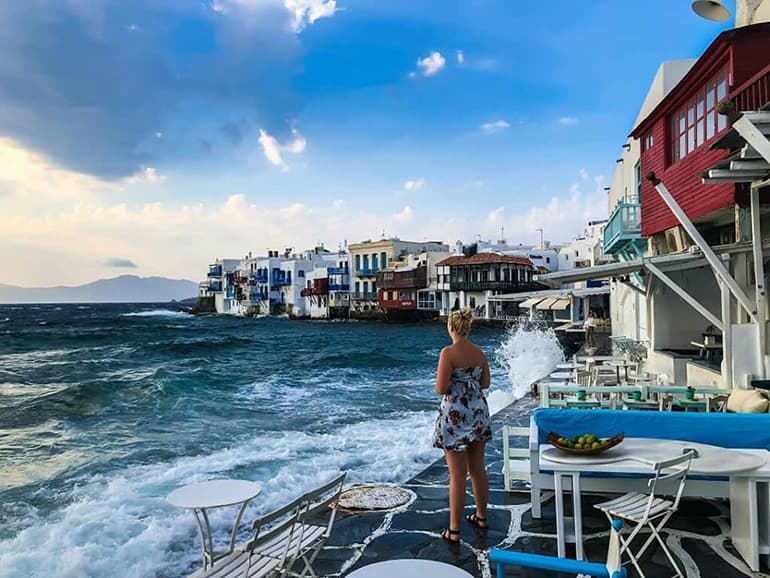
How much does a Europe trip cost?
Let’s take a look at a few examples of different kinds of holidays you could have in Europe, and address some of those big-ticket costs that need to be budgeted for.
The lovey-dovey couple
This romantic pair is travelling through London for 2 weeks during its beautiful, warm summer. Between them, they’ll need just under $10,000 AUD for flights, accommodation and daily transport.
The solo backpacker
This lucky vagabond is travelling Solo (not even Chewbacca is invited). They’re hitting up France , Spain , Italy and Greece for a whole month of adventure. Depending on how frugal they decide to be, they’ll need about $4,000AUD for flights, accommodation and public transport. Don’t forget to budget your meals and adventures though!
The fun family
This wonderful family of 2 adults and 2 kids (under age 11) is going on a cruise to visit Barcelona during the school holidays – lucky kids… The parents will need to save around $13,000AUD worth of pennies to afford the flights, cruise and accommodation for this trip.
Note that these are your core expenses. Other costs from travel insurance, daily expenses like food and drinks, sightseeing, activities and all those shopping trips aren’t taken into account.
Costs of travelling Europe per day
We’ve looked at the big stuff, now let’s get into the intricate expenses.
First of all, a good holiday budget will keep in mind where you can tighten up on expenses – and where you can splurge! Having this type of flexible holiday budget is essential because you never know when an opportunity might come up that you don’t want to miss out on.
For a middle-of-the-road holiday (neither budget nor luxury living) we recommend from:
AU$100 to AU$150 per person, per day.
This will cover sightseeing, food and drinks, shopping and other nitty-gritties. But of course, there are heaps of ways to cut down on this cost – or add to it – to create your preferred budget.
Travel Money Oz Infographics_14_Blog.jpg
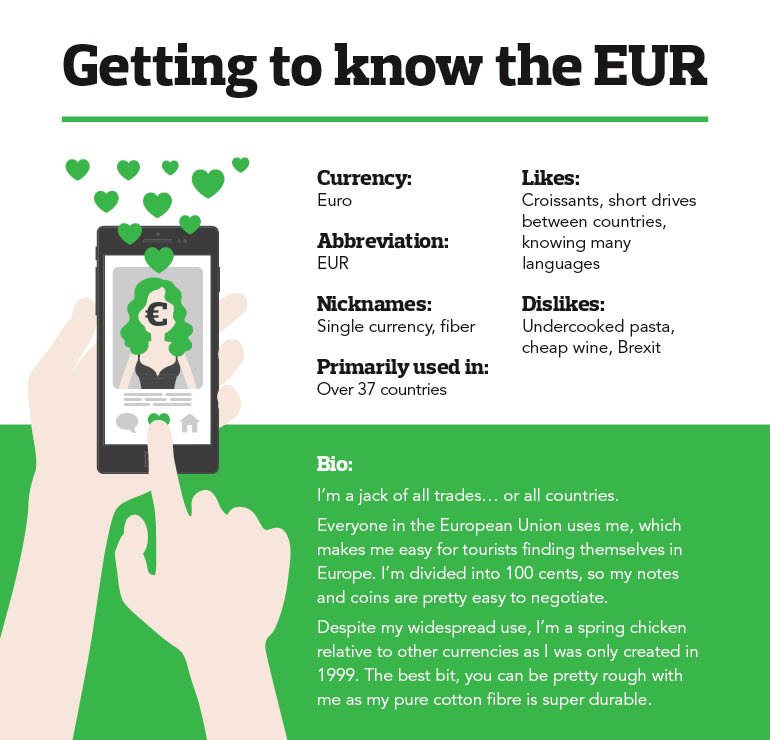
Consider your bookings
It helps knowing exactly what’s included in what you’ve booked. Does your hotel include breakfast in the per night cost? If it does, then that’s one less thing you need to budget for. Or does your accommodation have kitchen facilities? That gives you a cheap’n’easy, DIY meal option.
You can also look for other ways to save. Can you purchase a public transport pass, rather than buying single tickets (as usually, this will offer some savings)? Or can you purchase a sightseeing pass that includes entry costs and public transport? If you can, why not go for it and save.
Final words on budgeting
Well, that was probably a lot to take in, so let’s finish up with some easy-peasy dot points.
- It can help to have a pre-agreed cost for things (pre-agreed with yourself, or your travel companions if you’re splitting costs). This avoids arguments, stress and overspending.
- Put time and research into your ‘per day’ budget and include the things you really want to do. Once you know the costs, you have a goal to save for.
- It pays to book things in advance, but sometimes you might be able to find a cheaper price when you are in the country
- Don’t forget to factor in your pre-travel costs (e.g. travel insurance, immunisations and visas).
- Budget for cheap eats some days so you can gorge other days. From enjoying a glass of champagne at the top of the Eiffel Tower to devouring food at Germany’s food stalls.
- Don’t forget those sneaky costs (e.g. transfers, tours and tipping).
If you still need help with setting a holiday budget, our travel money experts have a handy budgeting tool available in any of our 165 stores across Australia and New Zealand.
*Flight costs based on search from www.flightcentre.com.au and are indicative costs only, based on prices available on 10 August 2018. ^Accommodation costs are based on an average per night price for budget , moderate or luxury hotels, as indicated in the table. ~Cruise cost is based on search from www.ncl.com for a 7 night Western Mediterranean cruise onboard Norwegian Epic, departing Barcelona in May 2019, and is an indicative cost only, based on prices available on 10 August 2018. **Rail Pass cost is based on search from http://www.eurail.com and is an indicative cost only. COST COMPARISON TABLE: All costs are based on estimated approximate costs from major metropolitan cities in each country. “From” costs indicate costs that start from the indicated price and may be higher than shown. Average prices indicate a typical estimated cost you would pay for the indicated item. Prices may vary from time to time, and in different cities and towns within each country. Cities included are: London, United Kingdom; Rome, Italy; Paris, France; Berlin, Germany; Barcelona, Spain; Athens, Greece; Budapest, Hungary; Prague, Czech Republic; Amsterdam, The Netherlands. This blog is provided for information only and does not take into consideration your objectives, financial situation or needs. You should consider whether the information and suggestions contained in any blog entry are appropriate for you, having regard to your own objectives, financial situation and needs. While we take reasonable care in providing the blog, we give no warranties or representations that it is complete or accurate, or is appropriate for you. We are not liable for any loss caused, whether due to negligence or otherwise, arising from use of, or reliance on, the information and/or suggestions contained in this blog.
AUD News: Global growth concerns continue to put a cap on Aussie dollars performance
Travel hacks: halloween hotspots around the world, more like this.

Nomadic Matt's Travel Site
Travel Better, Cheaper, Longer
Europe Travel Guide
Last Updated: April 18, 2024

From beautiful Paris to smoke-filled coffeeshops in Amsterdam, Oktoberfest to La Tomatina, Europe is a massive, diverse continent with an unlimited assortment of things to see and do. You won’t have any problem filling your time, whether you’re backpacking Europe for a few months on a budget or just spending a few weeks there on a well-earned vacation.
The continent boasts wonderful beaches, historical architecture, amazing wine, and tons of world-class festivals. Every country is incredibly different from the next too, providing limitless variety in what you do during your trip.
I first backpacked Europe in 2006 and was hooked immediately. I’ve been visiting every year since, have run tours around the continent, and even wrote a book on traveling in Europe . It’s a destination I love and never get tired of exploring.
This guide will give you an overview of Europe and the tips and tricks you need to start planning your trip. I’ve also written extensive travel guides to each country on the continent (linked below in this post) so you can get more in-depth information for your specific itinerary too!
Table of Contents
- Things to See and Do
- Typical Costs
- Suggested Budget
- Money-Saving Tips
- Where to Stay
- How to Get Around
- How to Stay Safe
- Best Places to Book Your Trip
- Related Blogs on Europe
Click Here for Country Guides
Top 5 things to see and do in europe.

1. Tour the Greek Islands
These islands are the mecca of summer beach fun and each is unique in its own great way. There’s Ios (beach party central with archeological ruins and awesome boat tours); Kos (ancient ruins and nature); Crete (Bronze Age ruins of Knossos, hiking, beaches, and wine), Santorini (iconic blue water, white buildings, and local wineries); Mykonos , (the upscale party island with beautiful beaches, villages, and sunsets), Naxos (best island in the Cyclades). Plus, Milos, Corfu, Lemnos, Zakynthos, and so many more! With hundreds of islands in the country, you can always find what you are looking for!
2. Ride the rails
Europe is famous for its international rail system. Rail passes like the Eurail Pass have been around forever and still make it very easy to get from country to country on a relatively small budget (and with lots of flexibility). Europe has some of the fastest trains in the world that travel up to an incredible 217 mph (350 kph). The whole continent is connected by trains and there’s a growing push for even more connections and long-distance, high-speed trains in order to reduce flying and help combat climate change. There’s nothing more quintessential than riding the trains in Europe and I encourage you to take as many trains as possible. It’s one of the best ways to see the continent.
3. Get lost in Paris
The “City of Lights” is everything people say it is. I fell in love with it the first time I stepped foot in Paris . The city is just magical. You have a ton of museums, cafes, jazz clubs, famous art, and beautiful architecture. I love just strolling around the streets of the Quartier Latin (Latin Quarter) or Montmartre neighborhood as it makes for a breathtaking day. Another one of my favorite things to do here is just sit in the Jardin des Champs-Élysées park and picnic like the Parisians. For something a bit different, check out the famous Catacombs and Paris Sewer Museum. With so much to offer in the way of culture, history, and gastronomy, it would take years to see everything here but you can still get a good feel of the city in a few days.
4. Go city hopping
There are so many amazing cities in Europe that we’d need a top 100 to list them all. Here are some of my personal favorites and must-see cities: London is rich in history, culture, and the famous Big Ben clock; Edinburgh is a vibrant medieval city with cozy pubs and a famous castle with a huge New Year’s Eve Party; Amsterdam has cozy coffee shops and canopied tree-covered canals; Berlin has a wild party scene, street art, and the Berlin Wall; Barcelona has tapas, beach, and unique Gaudi architecture; coastal Lisbon has colorful tiles, old tramcars, cobblestone streets and plenty of fresh seafood; Prague has a beautiful intact Old Town, incredible architecture and eclectic bars; Tallinn Estonia has beautiful medieval buildings with colorful roofs. Florence is a mecca for Italian Renaissance architecture, art history, and gelato; Stockholm mixes medieval architecture and modern art and design. Crisscross the continent, take in the culture, and enjoy all the historic cities!
5. Hit the Alps
Whether you go skiing in the winter or hiking in the summer, the Alps hold some of the most breathtaking views in all the world. You don’t even need to be an expert hiker because there are mountain trails for all levels and crystal-clear Alpine lakes. Check out the spectacular Eibsee trail loop in Bavaria at the foot of Die Zugspitze, Germany’s tallest mountain, for the clearest, multi-colored, sparkling lake you’ve ever seen. Or the Männlichen Kleine Scheidegg Panorama trail in Switzerland’s stunning green and snow-capped Alps. Or visit Italy’s Dolomites in South Tyrol for the scenic Seceda trail. The Alps have trails for every fitness level and in every season.
Other Things to See and Do in Europe
1. tour amsterdam.
I love Amsterdam so much that I lived here for a short period of time in 2006. Here cobblestone and brick streets weave around lovely canals as people ride their bikes to and fro. My favorite things to enjoy here are Amsterdam’s vibrant art and music scene and there are also a ton of interesting museums here like the Anne Frank House, FOAM, the history museum, and the hemp museum. Be sure you get out of the center into Jordaan and Oost with their wonderful outdoor cafes and fewer tourists. Also, a visit to Amsterdam wouldn’t be complete without a canal cruise to visit the many islands and there are many to choose from that include snacks and drinks, sunset cruises, live guided tours, and more.
2. Hang out in Barcelona
Barcelona is a city that goes 24 hours a day, 7 days a week. It truly could give NYC a run for the “city that never sleeps” title. Be prepared for late-night dinners and parties until dawn. Besides a great food and nightlife scene, there is a wonderful beach, tons of Gaudi architecture (including the fairytale-like Parc Güell, as well as the iconic Sagrada Familia , which has been under construction for over 100 years!), incredible food tours, one of the best history museums in the country, and lots of outdoor spaces. What I love about Barcelona is that when you’re ready to chill, you can wander around Parc de la Ciutadella and marvel at the majestic fountains, plant life, and buildings created from an ornate military fortress.
3. Visit Berlin
Hip and trendy Berlin is an energetic destination. It is one of Europe’s most affordable capital cities, with a vibrant music and art scene and a growing foodie movement. Be sure to spend some time learning about the city’s darker history via the many excellent museums, memorials, and landmarks. The East Side Gallery, a section of the Berlin Wall that’s now painted with murals, and the Memorial to the Murdered Jews of Europe are two especially powerful reminders of Germany’s past. For all periods of German history, don’t miss the Deutsches Historisches Museum (German Historical Museum) – it’s one of the best history museums in the world. Once you’ve had your fill of history, relax in Berlin’s many green spaces, from Tempelhof Field, the site of a former airfield and popular local hangout spot, to Tiergarten, a tree-covered former hunting ground for 17th-century aristocrats.
4. Drink beer at Oktoberfest
Oktoberfest is a must for anyone going to Germany at the end of September. While not a budget option since beers now cost 15 € a maß, I love the energy and friendly camaraderie this event inspires. For two weeks, millions of people from all over the world gather for lots of beer, excitement, music, and wild fun. Watching thousands of people sing together, raising quart-sized beer mugs for endless toasts, and enjoying the general party atmosphere makes you feel good about the world. (Or maybe that’s just the beer?) Just be sure to book your accommodation well in advance and be prepared to pay top prices for them. If you don’t have an outfit, don’t worry, there are plenty of shops even at the main train station where you can buy a Bavarian dirndl dress and men’s lederhosen.
5. Experience London
Get a taste of English culture in diverse London . The museums here are some of the best in the world (most are free) and include the Tate, the British Museum, the City Museum, the National Gallery, the Historical Museum. There’s no shortage of iconic sights here as well, with Big Ben, the House of Parliament, the London Eye, the Tower of London, Tower Bridge, and of course, Buckingham Palace. I love London’s diversity because of the countless international eateries with great food and wonderful pub culture, perfect for after a long day seeing the sights. Head to Brick Lane on the weekends for some amazing food and craft markets. I prefer Paris to London, but there is something sophisticated and fun about London. Just watch those pints — London is not a cheap destination!
6. Get outdoors in Scandinavia
My favorite region in Europe is Scandinavia. The quality of life here is high, the people are beautiful and friendly, and the cities are clean and historic. Cycling the cities, taking canal tours, hiking the vast forested areas, archipelago hopping, enjoying fika (a Swedish coffee break), and warming up in saunas are just a few of the popular activities that await you here. True, this area of Europe is not cheap, but there are plenty of ways to reduce your expenses. Don’t let the high prices scare you away. Highlights for me include Copenhagen , Stockholm , Gotland, Norway’s fjords, and Lapland in Finland .
7. Get enchanted in Prague
Prague has an amazing history and is one of the most beautiful and picturesque cities I’ve ever seen. Highlights include the 9th-century Prague Castle, the magnificent Charles Bridge (built in the 14th century and one of the oldest standing bridges in the world), the 10th-century old square with its iconic astronomical clock, and the winding Jewish Quarter. Even if you only have a few days there don’t miss the free walking tour which is one of my favorites in Europe and the best way to learn about the Old Town and the tragic history of the city that went from thriving Bohemian capital of art, music, and literature to part of the Iron Curtain after WWII. Some of my favorite gems here include the fantastic black light theater shows in 4D and the one-of-a-kind medieval dinner show in an old tavern complete with musicians and jugglers not to mention hearty food and drinks. During the weekends it heaves with people enjoying the bars, cheap beer, and delicious food so try to visit during the week (and in the spring or fall) to beat the crowds.
8. Relax on the French Riviera
Here, you can pretend to live the high life for a little bit. Have fun in the sun, relax on the beach, swim in azure blue water, hobnob with the rich and famous, and sail on (or gaze at) gigantic yachts. As for cities, Nice is nice with its palm-tree-lined promenade, old town, and many art museums. If you want to go see how the rich and famous live, spend an afternoon checking out Cannes to soak up some glamorous vibes on La Croisette where they hold the famous Cannes Film Festival. The kingdom of Monaco with its tiny streets, beautiful buildings, and world-famous casino is just a skip away too.
9. Enjoy the great outdoors in Interlaken
Located in the beautiful mountains of Switzerland, Interlaken is a gorgeous place to unwind with fantastic hiking, delicious hot chocolate, and plenty of outdoor sports. The area is full of natural attractions to explore, including the St. Beatus Caves (complete with a legendary dragon), the cascading 500-meter-high (1,640 feet) Giessbach Waterfalls, the Jungfraujoch mountain railway (which leads to the highest train station on the continent), and a plethora of lakes (hence the town’s name). It’s a good alternative to all the cities and museums. Interlaken is also a popular party destination for backpackers and other young travelers. By far, my favorite scenic and visually stunning trail was the Oberberghorn panoramic hike, where you can wander the green mountain ridge ogling the amazing views and the turquoise-blue Brienzersee.
10. Experience history in Rome
In this thriving historical city, you can’t walk two feet without stumbling over a ruin, making Rome a history buff’s dream. Its tiny streets are perfect for wandering as you explore the Colosseum, see the Forum and Palatine Hill, visit the Pantheon, spend time in Vatican City, admire the Spanish Steps, and toss coins into the famous Trevi Fountain. The skip-the-line tickets can definitely be worth it so you don’t waste time waiting outside attractions. Rome also has amazing food (it’s Italy, after all) and nightlife. Visit the Trastevere area for a taste of “local” Rome and chill bars. It’s my favorite area in the city because you feel like you’re in a small village in the middle of a big city.
11. Hike around the Cinque Terre
Cinque Terre is my favorite part of Italy. These five beautiful cliffside towns are perched near warm waters and beautiful olive and grape groves. There are wondrous and strenuous hikes in these hills; for a real challenge, take trail #8. Or just walk the coastline for something less difficult. Many activities here revolve around the coastline: kayaking, swimming, having a beach picnic or visiting the Technical Naval Museum. If you happen to be here in December or January, don’t miss the Nativity Manarola, the world’s biggest lighted nativity scene.
12. Tour Krakow
Krakow looks like it stepped out of a medieval postcard. It’s a hip, trendy, and youthful city that’s the center of education in Poland, meaning there are a lot of university students here. Most travelers come to party here (the vodka is cheap) but try to enjoy the city’s history and food besides just the bars. Walk the Royal Road through the Old Town to the 13th-century Wawel Castle, tour Schindler’s Factory (where Schindler saved over 1,200 Jews during World War II), and visit the sobering Auschwitz-Birkenau concentration camp. You can also take a fascinating day trip to the UNESCO World Heritage Wieliczka Salt Mine, a 13th-century mine with cavernous chambers, statues, chapels, chandeliers, and cathedrals all carved out of salt.
13. Visit the ruin bars in Budapest
The coolest nightlife in all of Europe is found in Budapest . Built in abandoned buildings, ruin bars feature funky art installations, repurposed furniture, and quirky decor. They are amazing, fun, and great places to meet locals, as people of all ages flock here. Open since 2001, Szimpla Kert is the original ruin bar and one of my favorites, along with Instant-Fogas Complex, which takes up an entire building and is actually many different bars in one. Don’t skip the ruin bars — they’re one of the most unique things about the city!
14. Explore Cornwall
The best part of England is outside London, yet unfortunately, not a lot of travelers leave London. Head west to the area of Cornwall for cheaper prices, welcoming locals, natural beauty, great hiking, rolling hills, plenty of medieval castles, and picturesque small towns. If you like biking, the Camel Trail from Bodmin to Padstow is worth the trip and you even pass by a local vineyard. It’s an easy way to spend a day (and it’s pretty flat so it’s not too hard to do.) Plus, I had the best fish and chips in Cornwall! Overall, it’s what you think of as “traditional England.”
15. Walk the Camino
El Camino de Santiago (The Way of Saint James) is an ancient pilgrimage route that stretches from France all the way across northern Spain. It is a 500 mile (800 km) trail that winds through incredible terrain, ending in Santiago de Compostela at the cathedral where St. James is supposedly buried. As a pilgrim, you get a “pilgrim’s passport” which allows you to stay in affordable pilgrim-only hostels, making this a surprisingly budget-friendly adventure. While it usually takes over a month to complete, you can just walk a section if you don’t have the time. To receive a “Compostela” (certificate of completion), you just need to walk the last 62 miles (100 km), which generally takes 4-5 days.
16. Throw tomatoes during La Tomatina
By far my favorite festival, the largest food fight in the world happens during the last Wednesday of August in Bunol, Spain. What started in 1945 as a local brawl has turned into a massive event drawing tens of thousands of people from all over the world. For about an hour, everyone throws tomatoes at each other, leaving streets ankle-deep in tomato juice. Afterward, everyone walks down to the river, cleans off, and then heads to the town square for sangria and music.
17. Find Dracula in Romania
Not a lot of people visit Romania but this underrated country in Eastern Europe has undiscovered yet picturesque medieval towns like Brasov (home to “Dracula’s castle”), Sighisoara, and Sibiu; gorgeous beaches on the Black Sea; and incredible hiking in the Fagaras Mountains — all at dirt-cheap prices. Other major sights include frescoed Byzantine monasteries, the steepled wooden churches of Transylvania, the hip university town Cluj-Napoca, the post-communist capital of Bucharest, and the Danube Delta, a huge nature reserve.
18. Drink whisky in Islay
Whisky has a long history on Islay , an island off Scotland’s west coast. It’s been made there since the 16th-century — first in backyards and then, starting in the 19th-century, in large distilleries. Over the years, whisky from the island came to be considered a specialty and was used to flavor a lot of other blends on the mainland. There are currently nine working distilleries on the island, all located along the island’s shores, with Laphroaig, Ardbeg, and Lagavulin being the most famous. Most distilleries here make single-malt Scotch, meaning that only one type of grain (barley) is used. My visit here was amazing and, even if you don’t like whisky, there are tons of good hikes and walks throughout this magnificent island.
19. Explore Iceland
Iceland is a magical country with majestic waterfalls, hidden hot springs around every corner, and sweeping vistas unlike anywhere else in the world. After my first visit, the country quickly became one of my favorite countries. With whale watching in the summer, the northern lights in the winter, and geothermal baths for soaking in year-round, there really is no bad time to visit! While Iceland’s main draw is the epic natural landscapes, it’s worth spending a couple of days in Reykjavik with its café culture, artsy feel, and brightly colored wooden row houses.
20. Sail the Croatian coast
With calm winds, short distances, a coastline littered with over 1,000 islands, and countless historical sites, Croatia is one of the world’s best sailing destinations. If you can, go during the shoulder season when you can find some great deals. Plan to stay at least a couple of days on one of the islands, with the most popular being Brac, Hvar, Krk, Cres, and Lošinj. However, don’t be afraid to get off the beaten path and explore some of the lesser-known islands such as Silba, Vis, and Lastovo. If you want to splash out and spend a week partying on a yacht, check out The Yacht Week, which hosts week-long parties, complete with DJs, from May-September. You can book a full boat to share with friends or just a cabin if you’re traveling solo. Prices start at 5,250 HRK per person and go up to 9,300 HRK.
21. Explore the Balkans
While the Balkans have become more popular with backpackers in recent years, it’s still largely overlooked by most budget travelers, despite being an extremely budget-friendly region. The Balkan peninsula is home to great (and again, overlooked) wine, beautiful medieval towns like Kotor and Mostar, stunning mountainous landscapes, beautiful pebble beaches, coffee culture, fresh, hearty yet inexpensive food, and museums covering the area’s history, including the most recent turbulent events of the early 1990s. I especially loved my time in Albania . Don’t miss the beautiful beaches in Ksamil, nicknamed the “Maldives of Europe’ as well as the mountain village of Gjirokastër, which was occupied by Romans, Byzantines, and Ottomans. The Balkans have so much to offer for every budget and every country has its unique cultural flavor.
22. Take a wine tour in the Loire Valley
Located in central France, the picturesque Loire Valley is a UNESCO World Heritage site and stretches 280 kilometers (174 miles) along the Loire River. One of the major wine-producing regions of France, the area is home to some of the best wines in the world, with over 1,000 vineyards open to the public. Even those who don’t drink wine will enjoy the beautiful small towns, great food, and the region’s over 300 impressive chateaux. I loved the medieval Chenonceau Castle and Chateau Villandry and the small villages like Saint-Florent-le-Vieil. Spring and Autumn are my favorite times to visit because you can go biking and do outdoor activities when it’s not too hot and there are fewer people. It’s an area not to be missed.
23. See Fado in Portugal
Fado is an important musical tradition in Portugal , originating in Lisbon and stretching back some 200 years. The word “fado” likely stems from the Latin word for fate, and it’s very haunting, poetic, and emotional music. Most of the songs follow themes of loss and mourning, and the music was popular with the working class (especially sailors). Performances normally take place in restaurants during dinner. In Lisbon, head to Clube de Fado, Tasca do Chico, Parreirinha de Alfama, or Senhor Vinho.
24. Tour green Slovenia
Slovenia is one of Europe’s least-visited destinations, which is mind-blowing to me because it’s an amazing place to visit. Slovenia offers all the beauty of Western Europe but at a fraction of the cost and with a fraction of the crowds. Perfect for outdoor adventure lovers, Slovenia offers rugged mountains, untouched landscapes, fantastic ski resorts, plentiful wine, sprawling cave systems, incredible food, and postcard-perfect lakes, such as the famous Lake Bled with its castle on an island. I loved Piran, Slovenia’s often overlooked coastal Venetian-style harbor town that was actually founded 3000 years ago. Stroll around its beautiful windy cobble-stoned streets, beautiful plazas, and take advantage of the many affordable restaurants right on the water. Make sure to also spend a few days in the country’s capital, Ljubljana, known as one of the continent’s greenest and most livable cities. Take a river cruise to see the city and enjoy the friendliness of the locals.
For more information on specific countries in Europe, check out the guides below:
- Albania Travel Guide
- Austria Travel Guide
- Belgium Travel Guide
- Belarus Travel Guide
- Bosnia & Herzegovina Travel Guide
- Bulgaria Travel Guide
- Czechia Travel Guide
- Croatia Travel Guide
- Denmark Travel Guide
- England Travel Guide
- Estonia Travel Guide
- Finland Travel Guide
- France Travel Guide
- Germany Travel Guide
- Greece Travel Guide
- Hungary Travel Guide
- Iceland Travel Guide
- Ireland Travel Guide
- Italy Travel Guide
- Latvia Travel Guide
- Lithuania Travel Guide
- Malta Travel Guide
- Moldova Travel Guide
- Montenegro Travel Guide
- Netherlands Travel Guide
- Norway Travel Guide
- Portugal Travel Guide
- Poland Travel Guide
- Romania Travel Guide
- Scotland Travel Guide
- Slovakia Travel Guide
- Slovenia Travel Guide
- Spain Travel Guide
- Sweden Travel Guide
- Switzerland Travel Guide
- Ukraine Travel Guide
Europe Travel Costs

Accommodation – Accommodation prices vary greatly by region. In Western Europe, hostel dorm rooms cost between 25-45 EUR per night, depending on the room’s size and the popularity of the hostel. I stayed in a 6-bed dorm in Berlin for 20 EUR, while the same one would have cost me around 45 EUR in Paris. A room in Paris costs on the higher end and a room in cheaper Athens costs on the lower end.
In Eastern Europe, hostel dorm rooms cost between 10-15 EUR per night depending on the size of the dorm room and the popularity of the hostel. The further east you go, the cheaper it gets. Expect to pay around 30-60 EUR per night for a private room that sleeps two.
In Scandinavia, hostel dorm beds cost around 25-45 EUR, while private rooms are 65-80 EUR. Budget hotels start around 85 EUR.
Most accommodations offer free linens, free Wi-Fi, and a lot offer free breakfast, but it’s important to check specific websites for exact amenities.
Campsites cost between 10-15 EUR per night for a basic plot for two without electricity.
Food – Food traditions in Europe run deep, stretching back centuries to become integral parts of each country’s culture. From baguettes in France to tapas in Spain, from hearty Eastern European stews and goulash to the fresh vegetables and olive oils of the Mediterranean, European cuisine varies as much as the countries themselves. Food prices differ greatly across the continent, so check individual country guides for specifics.
But no matter where you are, even in the more expensive countries, finding places to eat within your budget is easier than you might think. Throughout Western Europe, you can find small shops, street food stalls, or food trucks where you can get sandwiches, gyros, kebabs, slices of pizza, or sausages for between 3-7 EUR. These shops are most often found in train stations, bus stations, and main pedestrian areas, and offer cheap food alternatives that can have you eating on 12-17 EUR per day. Fast food (think McDonald’s) costs around 7-10 EUR for a combo meal.
Turkish, Middle Eastern, and Vietnamese eateries abound in Germany, while Indian food is incredible and everywhere in the United Kingdom. Meals at these restaurants usually cost between 8-12 EUR.
Restaurant meals in casual, traditional eateries generally cost around 13-25 EUR for a main dish and drink. Food is much cheaper in the east than in the west, and in the west, northern regions like Scandinavia and the UK are more expensive than southern countries like Spain, Portugal, and Italy.
In Eastern Europe, even if you are eating out for all your meals, you can still get by on a food budget of as little as 15 EUR per day.
For drinks, a pint of beer is 2-5 EUR, a glass of wine is 2-7 EUR, a cappuccino is 2-5 EUR, and cocktails range from 6-14 EUR.
If you eat out, do so at lunch and get the prix-fixe menu (two-course or three-course set menu). Restaurants offer this set menu during lunch, and with prices between 10-20 EUR, it’s a way better deal than the regular dinner menu. You can also get affordable lunches at outdoor markets. So many European cities have huge fresh food markets throughout town.
You can cook your own food for around 45-65 EUR per week. This gets you basic staples like rice, pasta, seasonal produce, bread, and some meat. You can save money by shopping at discount supermarkets like Profi, Lidl, Aldi, and Penny Market.
If you want to save big money on meals, head to one of the markets, pick up some cheese, wine, bread, meats, or anything else, and go to the park for a picnic. (Or grab a sandwich for later!) You’ll find the locals doing the same thing, and it’s one of the cheaper ways to get a true taste of local food.
Backpacking Europe Suggested Budgets
Prices for travel in Europe vary greatly depending on how far north, east, south, or west you travel. If you stick to the budget accommodations, food, and tours listed here and use all my tips on saving money, you need about 65-110 EUR per day in Western Europe, 40-50 EUR in Eastern Europe, and about 85-130 EUR in Scandinavia.
Those numbers reflect a traveler who stays in hostels, cooks some meals and eats out cheaply, enjoys a few drinks, and sticks to free and cheap activities like hiking, walking tours, and enjoying nature. This is your typical backpacker budget. You aren’t going to have a fancy time, but you aren’t going to want for anything either.
However, by getting tourist cards and rail passes, avoiding flights, occasionally Couchsurfing or camping, cooking all your meals, and not drinking, you can travel a lot cheaper. On this budget, you could do Western Europe on 35-45 EUR per day, Eastern Europe on 20-25 EUR, and Scandinavia on 50-65 EUR. That would require you to take a train or a bus or hitchhike everywhere, skip most museums, and limit how often you go out.
Generally, the suggested daily budget for Europe is 80-120 EUR. You can use the chart below to get an idea of how much you need to budget daily. Keep in mind these are daily averages – some days you’ll spend more, some days you’ll spend less (you might spend less every day). We just want to give you a general idea of how to make your budget. Prices are in EUR.
Europe Travel Guide: Money-Saving Tips
Individual country guides have more specific information on how to save money in them but here are some general tips on cutting your costs while you explore Europe:
- Picnic – This continent has a lot of little shops where you can buy pre-made sandwiches or ingredients to make your own. Many supermarkets have delis as well where you can get food to go. Buy some food, eat outside, and watch the city and its people go by. It’s a much more enjoyable and cheaper way to eat.
- Eat local and cheap – Not into picnicking? Eat at local sandwich shops, pizza parlors, Maoz, Wok to Walks, and outdoor street vendors. Avoiding restaurants and eating at a lot of the local “grab n’ go” places gives you a taste of the local cuisine at a much cheaper price. If you’re really on a budget, use your creative cooking skills to prepare meals at the hostel as well.
- Stay with a local – Hostels can add up really quickly. If you don’t have any friends with whom you can stay, consider using Couchsurfing , which connects you with locals who let you stay with them for free. Plus, they tend to also have meetups to meet other locals and travelers. It’s a great way to save on accommodation and meet a local who can share their insider tips and advice.
- Camp in a garden – A very good camping service specific to Europe is Campspace , which allows you to pitch a tent in someone’s backyard for free or for a small fee (around 10-20 EUR). All of the garden owners have profiles that tell you what services and facilities they offer. Also, many countries allow wild camping (like Sweden), which can save you a fortune if you have a tent.
- Take the bus – Budget bus companies like Flixbus can take you across the continent for cheap. I personally feel it’s best for day travel as sitting up for an overnight bus isn’t really ideal for sleeping. It isn’t glamorous, but with tickets starting at 5 EUR, you really can’t complain!
- Get a Rail Pass – Eurail Passes have saved me hundreds of dollars. If you are traveling far distances and through many countries, they are a great deal.
- Take the free city tours – One of the great things about Europe is that you can find free walking tours in all the major cities. They can be a great way to see the city attractions, take in some history, and learn your bearings without spending any money. Just make sure to tip your guide at the end!
- Plan accordingly – Plan your trip around Europe so you avoid doubling back. Transportation is a big expense so proper planning can save you a lot of money (and time). Go in a straight line or a loop. Booking your accommodation ahead helps you save as well since cheap, good places unsurprisingly get reserved first. One thing I’ve learned is that waiting until the last minute means you get stuck with expensive places or cheap places no one wants.
- Fly cheap – If you know where you are going and a train won’t do, try to book flights early. You can often get round trip fares for as little as 5 EUR from many of the European discount airlines like Ryanair or Wizz. Many capital cities have smaller airports farther from the city with ‘inconvenient’ times but cheaper fares. Keep in mind you might need to factor in an early morning Uber or taxi if the busses aren’t running and you have an early flight!
- Drink less – Those 5 EUR beers add up. Hit happy hours or pick and choose when you party. Hostel bars are a good place to get cheap drinks or buy your alcohol at the supermarket. Plus, in Europe, it’s legal to drink outside in parks, plazas, by the lakes or rivers. You’ll find you can save a lot of money by not going to bars and clubs. Partying your way across the continent will destroy your bank balance in no time.
- Get a city tourist card – Many local tourism offices sell a tourism card for all their attractions, tours, and restaurants. This card gives you free entry and substantial discounts on all the attractions and tours in a city, free local public transportation (a huge plus), and discounts at a few restaurants and shopping malls. They save a ton of money. If you plan on doing a lot of sightseeing, get one of these cards.
- Rideshare – If you’re flexible in your schedule, use the ridesharing service BlaBlaCar to catch rides with locals between cities (or countries) by paying a small fee. It’s like Airbnb but for rides. I used this service in Switzerland and, not only did I save a lot of money, but I got to meet interesting people and learn about local culture and life. Drivers are verified and it’s perfectly safe, though sometimes rides cancel at the last minute (which is why you need to be flexible). Check their ratings first and try to use rides where the person has done many trips.
- Bring a water bottle – The tap water is safe to drink in most of Europe, so bring a reusable water bottle to save money and reduce your plastic use. LifeStraw is my go-to brand as their bottles have built-in filters to ensure your water is always clean and safe.
- Get a HostelPass – HostelPass is a discount membership for hostels in Europe. Members get 10-20% off select hostels around Europe, as well as perks like free breakfast or free drinks. There are discounts on tours and activities too. It’s a great way to save money if you’re bouncing around Europe as they have hostels in 18 countries around the continent.
Where to Stay in Europe
Europe has a ton of budget accommodation options. The individual country and city guides have tons of recommendations but here’s a short list of some of my favorite budget hostels and hotels around Europe:
- The Flying Pig (Amsterdam, The Netherlands)
- Hotel 54 (Barcelona, Spain)
- Generator Hostel (Copenhagen, Denmark)
- Harcourt Hotel (Dublin, Ireland)
- Castle Rock (Edinburgh, Scotland)
- Ios Palm Pansion (Ios, Greece)
- Greg and Tom’s Party Hostel (Krakow, Poland)
- Largo da Sé Guest House (Lisbon, Portugal)
- Sophie’s Hostel (Prague, Czech Republic)
- The Yellow (Rome, Italy)
- City Backpackers (Stockholm, Sweden)
How to Get Around Europe

Public transportation – Transportation around most European cities is by tram, subway, or bus. Prices are typically around 2 EUR for a one-way ticket in Western Europe and closer to 1 EUR in Eastern Europe. Most large cities also have day passes available that offer unlimited public transportation. These passes are usually 5-12 EUR per day.
In large cities with international airports, there is usually a bus or train available that ferries travelers from the downtown core to the airport. Expect to pay around 5-15 EUR to get to/from the airport.
Bus – Buses are not quite as comfortable as Europe’s trains, although certain lines do have great amenities (like roomy seats and Wi-Fi). While buses are not the most efficient way to travel around the continent, they’re certainly dependable, reliable, and cheap. You can find last-minute rides for as little as 5 EUR. A route from Berlin to Munich is about 25 EUR, while Paris to Bordeaux can be as low as 10 EUR. Longer routes, like Amsterdam to Copenhagen, start at around 47 EUR.
Each country has its own national bus service, but some lines also take you long distances internationally. Megabus and Flixbus (which now owns Eurolines) are the most popular companies.
Train – Train travel is a great way to see Europe. Intercity train prices vary wildly from country to country, depending on whether you take the slow train or a high-speed train and how far in advance you book. For example, a high-speed train from Berlin to Munich costs around 38-60 EUR, Bordeaux to Paris is about 50-85 EUR, and Madrid to Barcelona ranges from 45-85 EUR. Non-high-speed trains and other intercity lines are a lot cheaper, generally costing about 40-50% of the price of high-speed trains. Eastern Europe inter-country trains usually cost between 45-100 EUR when the ticket is booked last minute. Short train rides of 2-3 hours within countries cost about 27 EUR.
To find routes and prices for trains around Europe, use Trainline .
You may also want to consider getting a Eurail Pass , which allows travelers to explore Europe by providing a set number of stops in a specific time period. These passes are continent-wide, country-specific, or regional. It can potentially save you hundreds of dollars.
Ridesharing/Car sharing – If your schedule is flexible, use a ridesharing service and catch rides with locals between cities (or countries). Drivers are verified and it’s perfectly safe. BlaBlaCar is the most popular.
If you’d rather rent a car yourself and find passengers to share a ride with, use Discover Cars to find the best car rental prices.
Flying – Budget airlines are so prolific that competition helps keep fares low. You can often find tickets where the fare is just 5 EUR round-trip! Companies like EasyJet, Ryanair, Wizz, and Vueling offer mind-blowingly cheap flights throughout Europe. Book at least a month early to scoop up great deals.
Make sure that the airport they fly into isn’t too far out of your way (transportation from the secondary airport sometimes negates the savings from using the budget airline itself).
Keep in mind that you’ll have to pay to check your baggage on these cheap flights. It costs about 25-39 EUR for one checked bag. If you wait to pay for your luggage at the gate, you end up paying almost double. Travel carry-on only to avoid this added cost.
Hitchhiking – Hitchhiking in Europe is very safe, but it’s not for everyone. Hitching is quite common around the continent and I’ve met a number of travelers who have done it (I, myself, traveled this way in Bulgaria and Iceland). Some countries are very supportive (Romania, Iceland, Germany) while others may be a bit more time-consuming (Italy, Spain). HitchWiki is the best website for hitchhiking info.
Here are my suggested articles for how to get around Europe:
- 7 Cheap Ways to Travel Across Europe
- Are Eurail Passes a Giant Scam or Do They Save You Money?
- The Ultimate Guide to Finding Cheap Flights
When to Go to Europe
There’s no wrong time to visit Europe. Peak season is summer, when Europe gets crowded and August is the time most European families are at the beach so everything becomes more crowded and expensive. But the overall atmosphere and weather are great during this time, so it’s still worth visiting during peak season (just book your accommodation in advance — especially in August). Keep in mind it’s much hotter in summer so if you like AC, be sure to check that your hostel or hotel has it before you book. You can expect the most crowds in Western Europe. For this reason, I feel summer is a great time to visit the Balkans and the Baltics because many people head to the beaches in Spain, France, Italy, Croatia, and Greece.
Shoulder season is spring and fall (April-May and September-October). It’s still warm during this time but there aren’t as many crowds and prices are cheaper. This is my favorite time to visit hotspot places like Spain, Croatia and Greece, where it’s still hot enough to swim in the sea but you have way more room on the beach. It’s also a good time to go hiking in the Alps in Germany, northern Italy, Slovenia and Switzerland because it’s cooler during the day so you’re much less sweaty on the mountain without shade. The weather is good, the crowds are smaller, and the prices lower.
Winter is from November to February but in much of Central Europe, it’s wet and cold until March or April. It gets cold, even as far south as it gets (like Greece). On the other hand, the Christmas season has Christmas markets and festivals galore! Even if it’s cold, this is a cultural tradition you can’t miss and why I love Europe in December. There is hot mulled wine, sweets, and plenty of hot snacks, which vary by country. One of my favorites is Prague because the Old Town Square is lit up with a gigantic tree with aromas of crispy cinnamon pastries and mulled wine. Berlin takes their Christmas markets very seriously, so there are around 80 different markets with special themes.
Winter is fantastic in Europe for skiing and snowboarding but it doesn’t have to break the bank if you plan carefully. While Switzerland and France are probably the most famous, they are also expensive, but there are plenty of budget winter options.
How to Stay Safe in Europe
Europe is very safe for backpacking and solo traveling, even if you’re traveling solo, and even as a solo female traveler. Violent crimes against tourists are very rare. In fact, some of the safest countries in the world are in Europe. (I wrote a whole article about how Europe is safe to visit right now .)
That said, there are scams and petty crimes you should watch out for, especially around popular tourist landmarks. The most important thing to be aware of is pickpockets in crowds and on public transportation. Zip your bags and don’t put your mobile phone in a jacket pocket where someone could quickly take it. This should be obvious but don’t flash your money to let everyone know you have a huge wad of cash.
When choosing a hostel, look for ones with lockers. It’s always a good idea to carry around a padlock or combination lock. Most hostels are safe and travelers respect each other and I’ve rarely seen things happen to people’s valuables. Nevertheless, I always think that prevention is better.
As anywhere, the standard precautions apply (never leave your drink unattended at the bar, never walk home alone intoxicated, etc.). When at the bar, always keep an eye on your drink. Avoid walking home alone at night if you’re intoxicated.
For female travelers in particular, it’s always a good idea to have a bit of extra money on you just in case you need to take an Uber or taxi back by yourself so you don’t take unnecessary risks to save money. If you’re using apps to date people while traveling, please use common sense and meet in public places. Since I’m not a female traveler, please check out the numerous female bloggers who have first hand knowledge of this.
If you’re worried about scams, you can read about common travel scams to avoid here.
If you rent a vehicle, don’t leave any valuables in it overnight. Break-ins are rare, but it’s always better to be safe than sorry. Be aware that the UK drives on the left and that most rental cars in Europe will have manual transmissions unless you request otherwise.
When hiking, always bring water, sunscreen, and bandaids or foot plasters. There is nothing worse than being halfway up the mountain with a blister and nothing you can do about it!
Likewise, when at the coast, don’t forget not only to wear sunscreen! I can’t tell you how many times I’ve seen people get burnt to a crisp the first day. Be sure to check the weather before you depart and dress accordingly.
If you do experience an emergency, dial 112 for assistance.
Always trust your gut instinct. Make copies of your personal documents, including your passport and ID. Forward your itinerary to loved ones so they know where you are.
The most important piece of advice I can offer is to purchase good travel insurance. Travel insurance will protect you against illness, injury, theft, and cancellations. It’s comprehensive protection in case anything goes wrong. I never go on a trip without it as I’ve had to use it many times in the past. You can use the widget below to find the policy right for you:
Europe Travel Guide: The Best Booking Resources
These are my favorite companies to use when I travel. They consistently have the best deals, offer world-class customer service and great value, and overall, are better than their competitors. They are the companies I use the most and are always the starting point in my search for travel deals.
- Skyscanner – Skyscanner is my favorite flight search engine. They search small websites and budget airlines that larger search sites tend to miss. They are hands down the number one place to start.
- Hostelworld – This is the best hostel accommodation site out there with the largest inventory, best search interface, and widest availability.
- Booking.com – The best all around booking site that constantly provides the cheapest and lowest rates. They have the widest selection of budget accommodation. In all my tests, they’ve always had the cheapest rates out of all the booking websites.
- HostelPass – This new card gives you up to 20% off hostels throughout Europe. It’s a great way to save money. They’re constantly adding new hostels too. I’ve always wanted something like this and glad it finallt exists.
- Get Your Guide – Get Your Guide is a huge online marketplace for tours and excursions. They have tons of tour options available in cities all around the world, including everything from cooking classes, walking tours, street art lessons, and more!
- The Man in Seat 61 – This website is the ultimate guide to train travel anywhere in the world. They have the most comprehensive information on routes, times, prices, and train conditions. If you are planning a long train journey or some epic train trip, consult this site.
- Rome2Rio – This website allows you to see how to get from point A to point B the best and cheapest way possible. It will give you all the bus, train, plane, or boat routes that can get you there as well as how much they cost.
- FlixBus – Flixbus has routes between 20 European countries with prices starting as low 5 EUR! Their buses include WiFi, electrical outlets, a free checked bag.
- SafetyWing – Safety Wing offers convenient and affordable plans tailored to digital nomads and long-term travelers. They have cheap monthly plans, great customer service, and an easy-to-use claims process that makes it perfect for those on the road.
- LifeStraw – My go-to company for reusable water bottles with built-in filters so you can ensure your drinking water is always clean and safe.
- Unbound Merino – They make lightweight, durable, easy-to-clean travel clothing.
- Top Travel Credit Cards – Points are the best way to cut down travel expenses. Here’s my favorite point earning credit cards so you can get free travel!
GO DEEPER: Nomadic Matt’s In-Depth Budget Guide to Europe!

While I have a lot of free tips on Europe, I also wrote an entire book that goes into great detail on everything you need to plan a trip here on a budget! You’ll get suggested itineraries, budgets, even more ways to save money, my favorite restaurants, prices, practical information (i.e. phone numbers, websites, prices, safety advice, etc etc), and cultural tips.
I’ll give the insider view of Europe that I got from years of traveling and living here! The downloadable guide can be used on your Kindle, iPad, phone, or computer so you can have it with you when you go. Click here to learn more about my book on Europe!
Europe Travel Guide: Related Articles
Want more tips for your trip? Check out all the articles I’ve written on Europe travel and continue planning your trip:

The 6 Best Hotels in Copenhagen

The 6 Best Hotels in Florence

The 7 Best Hotels in Madrid

The 6 Best Hotels in Vienna

The Best Walking Tours in Barcelona

How to Be a Digital Nomad in Europe
Get my best stuff sent straight to you, pin it on pinterest.
- Where To Stay
- Transportation
- Booking Resources
- Related Blogs
Europe Travel Money Guide
The euro single currency is managed by the Economic and Monetary Union (EMU), which also coordinates Europe’s economic and fiscal policies.
What is Europe's Currency?
Denominations of euro, european money payment options, european coins and notes, best travel cards for europe, how much does a trip to europe from australia cost, how much does it cost to travel in europe, europe food costs, europe transport costs, activity prices in europe, europe visa costs, good to know - europe money tips, european countries and the euro, the perfect companion for europe: the travelex money card, other ways to get euros, travel insurance, travel money card, other services, historical rates, track the eur, find a store, international sim cards, frequently asked questions about money in europe, do i need cash in europe, how much spending money do i need for europe, do i have to tip in europe, can i use travellers cheques in europe, can i still use the euro in european countries that do not use it, travel to japan faq, travelex info, join the conversation, customer support.

Popular Destinations

All Destinations
- Aland Islands
- Canary Islands
- Czech Republic
- El Salvador
- Europe & UK
- Faroe Islands
- Indonesia (Bali)
- Liechtenstein
- Middle East
- Netherlands
- New Zealand
- North America
- Philippines
- Saudi Arabia
- South Africa
- South America
- South Korea
- Switzerland
- United Arab Emirates (Dubai)
- United Kingdom
- United States of America
- Vatican City
Your cart is empty
🔥 BUY ONE, GET ONE 25% OFF EUROPE ESIMS & SIM CARDS 👉 SHOP NOW

Travelling to Europe from Australia: A Comprehensive Guide
Travelling to Europe from Australia can be an exciting experience, with the opportunity to explore new cultures, visit historic landmarks, and indulge in delicious cuisine. However, it can also be a daunting task, as there are many factors to consider, such as flights, visas, accommodation, and transportation. In this comprehensive guide, we will cover everything you need to know to make your European adventure a success.
One of the first things to consider when planning a trip to Europe from Australia is the flight. There are several airlines that offer direct flights from Australia to Europe, including Qantas, Emirates, and Singapore Airlines. However, you can also find indirect flights that can be cheaper but take longer. It's important to compare prices and flight times to find the best option for you.
When booking your flight, consider the time of year you plan to travel. Peak travel season in Europe is during the summer months, from June to August, and flights can be more expensive and crowded during this time. If you are flexible with your travel dates, consider travelling in the shoulder season, from April to May or September to October, when prices are generally lower and crowds are smaller. We also highly recommend pre organising a Europe SIM card for when you land.
Australian citizens do not need a visa to travel to most European countries for tourism purposes for up to 90 days. However, it's important to check the visa requirements for the countries you plan to visit, as some may have different rules and regulations. For example, if you plan to stay in Europe for more than 90 days or work while you're there, you may need to apply for a visa. It's also important to make sure your passport is valid for at least six months after your planned departure date.
Transportation
Once you arrive in Europe, you'll need to decide how you want to get around. Public transportation is generally very good in Europe, so you can easily travel between cities by train or bus. If you're planning to visit multiple countries, you might want to consider purchasing a Eurail pass, which allows you to travel on trains in most European countries. The pass is available in a variety of options, including consecutive days, flexible days, and one-way tickets. It's important to research the options and prices to find the best option for you.
If you prefer to drive, you can rent a car in Europe, but it's important to note that driving rules and regulations may differ from those in Australia. You will need an International Driving Permit, which you can obtain from your local automobile club, and you may need to pay additional fees for insurance and tolls.

Accommodation
When it comes to accommodation, there are plenty of options to choose from. Hotels, hostels, and Airbnb rentals are all popular choices. It's important to research your options and book in advance, especially during peak travel season. Some cities, such as Paris and Rome, have a wide range of accommodation options, but they can be more expensive. Other cities, such as Berlin and Budapest, have a variety of affordable options.
If you're travelling on a budget, consider staying in a hostel or Airbnb rental. Hostels are a great option for solo travellers or those looking to meet other travellers, while Airbnb rentals can provide a more authentic and local experience.
Top Destinations
Europe is home to some of the world's most iconic landmarks, museums, and cities. Paris, Rome, and London are all must-see cities, but there are also many other hidden gems to explore. Barcelona, Berlin, and Amsterdam are just a few examples of cities with vibrant cultures and fascinating history.
Paris is known for its iconic landmarks, such as the Eiffel Tower and Notre-Dame Cathedral, as well as its museums, such as the Louvre and Musée d'Orsay. Rome, on the other hand, is known for its ancient history, with the Colosseum, Roman Forum, and Pantheon all must-see landmarks. London is home to Buckingham Palace, the Tower of London, and the British Museum, and is a great destination for those interested in history and culture.
Barcelona is known for its unique architecture, with landmarks such as the Sagrada Familia and Park Güell designed by the renowned architect Antoni Gaudi. Berlin is a city with a rich and complex history, from the remnants of the Berlin Wall to the vibrant art scene in the city's east. Amsterdam is a beautiful city with a network of canals and iconic landmarks such as the Anne Frank House and the Rijksmuseum.
Food and Drink
One of the highlights of any trip to Europe is the opportunity to indulge in delicious cuisine and drinks. Each country has its own unique dishes and specialties. France is known for its pastries, cheese, and wine, while Italy is known for its pasta, pizza, and gelato. Germany is famous for its sausages and beer, while Spain is known for its tapas and sangria.
It's important to try local cuisine and visit local markets and restaurants to experience the authentic flavors of each country. However, it's also important to be aware of any dietary restrictions or allergies and to communicate these to restaurant staff.
Safety and Security
While Europe is generally a safe destination for travellers, it's important to take precautions to ensure your safety and security. Keep your valuables, such as your passport and money, in a secure location, and be aware of your surroundings when walking in unfamiliar areas.
It's also important to be aware of scams and pickpocketing. Some common scams include people asking for money or offering to help with your luggage, so it's important to be cautious and avoid giving money or personal information to strangers.
Health and Medical Care
Before travelling to Europe, it's important to ensure you have adequate health insurance coverage. The Australian government recommends taking out comprehensive travel insurance, as medical treatment can be expensive in Europe. It's also a good idea to research the healthcare system in the countries you plan to visit and to carry any necessary medication or medical supplies with you.
It's important to be aware of any health risks, such as food or water-borne illnesses or insect-borne diseases. It's recommended to consult with a healthcare professional before travelling to ensure you have the necessary vaccinations and medications. Travelling to Europe from Australia can be an exciting and rewarding experience, but it's important to plan ahead and be prepared for the journey. From flights and visas to accommodation and transportation, there are many factors to consider. However, with careful planning and research, you can make the most of your European adventure and create memories that will last a lifetime.
Leave a comment
All comments are moderated before being published
Why is the activation date important?
- We need these dates to activate your SIM card so you can use it when the SIM is inserted into your device.
- For a seamless experience, make sure the date you insert at checkout is the exact date you want to start using the SIM, not earlier or later.
- Activation can take anywhere from a few minutes to a couple of hours.
Not sure on your dates yet?
- You can add in an estimated date for your SIM. Your SIM’s data & validity won’t start until you plug it into your device.
- Once you know your exact dates, please let us know via our live chat or at [email protected] so we can activate it for you at the right time.
What if you need to change the dates?
- You can reach out to us via our live chat or at [email protected] with your order number so we can change it for you.
Your cart is empty
🔥 BUY ONE, GET ONE 25% OFF EUROPE ESIMS 👉 SHOP NOW

Travelling to Europe from Australia: A Comprehensive Guide
Travelling to Europe from Australia can be an exciting experience, with the opportunity to explore new cultures, visit historic landmarks, and indulge in delicious cuisine. However, it can also be a daunting task, as there are many factors to consider, such as flights, visas, accommodation, and transportation. In this comprehensive guide, we will cover everything you need to know to make your European adventure a success.
One of the first things to consider when planning a trip to Europe from Australia is the flight. There are several airlines that offer direct flights from Australia to Europe, including Qantas, Emirates, and Singapore Airlines. However, you can also find indirect flights that can be cheaper but take longer. It's important to compare prices and flight times to find the best option for you.
When booking your flight, consider the time of year you plan to travel. Peak travel season in Europe is during the summer months, from June to August, and flights can be more expensive and crowded during this time. If you are flexible with your travel dates, consider travelling in the shoulder season, from April to May or September to October, when prices are generally lower and crowds are smaller. We also highly recommend pre organising a Europe SIM card for when you land.
Australian citizens do not need a visa to travel to most European countries for tourism purposes for up to 90 days. However, it's important to check the visa requirements for the countries you plan to visit, as some may have different rules and regulations. For example, if you plan to stay in Europe for more than 90 days or work while you're there, you may need to apply for a visa. It's also important to make sure your passport is valid for at least six months after your planned departure date.
Transportation
Once you arrive in Europe, you'll need to decide how you want to get around. Public transportation is generally very good in Europe, so you can easily travel between cities by train or bus. If you're planning to visit multiple countries, you might want to consider purchasing a Eurail pass, which allows you to travel on trains in most European countries. The pass is available in a variety of options, including consecutive days, flexible days, and one-way tickets. It's important to research the options and prices to find the best option for you.
If you prefer to drive, you can rent a car in Europe, but it's important to note that driving rules and regulations may differ from those in Australia. You will need an International Driving Permit, which you can obtain from your local automobile club, and you may need to pay additional fees for insurance and tolls.

Accommodation
When it comes to accommodation, there are plenty of options to choose from. Hotels, hostels, and Airbnb rentals are all popular choices. It's important to research your options and book in advance, especially during peak travel season. Some cities, such as Paris and Rome, have a wide range of accommodation options, but they can be more expensive. Other cities, such as Berlin and Budapest, have a variety of affordable options.
If you're travelling on a budget, consider staying in a hostel or Airbnb rental. Hostels are a great option for solo travellers or those looking to meet other travellers, while Airbnb rentals can provide a more authentic and local experience.
Top Destinations
Europe is home to some of the world's most iconic landmarks, museums, and cities. Paris, Rome, and London are all must-see cities, but there are also many other hidden gems to explore. Barcelona, Berlin, and Amsterdam are just a few examples of cities with vibrant cultures and fascinating history.
Paris is known for its iconic landmarks, such as the Eiffel Tower and Notre-Dame Cathedral, as well as its museums, such as the Louvre and Musée d'Orsay. Rome, on the other hand, is known for its ancient history, with the Colosseum, Roman Forum, and Pantheon all must-see landmarks. London is home to Buckingham Palace, the Tower of London, and the British Museum, and is a great destination for those interested in history and culture.
Barcelona is known for its unique architecture, with landmarks such as the Sagrada Familia and Park Güell designed by the renowned architect Antoni Gaudi. Berlin is a city with a rich and complex history, from the remnants of the Berlin Wall to the vibrant art scene in the city's east. Amsterdam is a beautiful city with a network of canals and iconic landmarks such as the Anne Frank House and the Rijksmuseum.
Food and Drink
One of the highlights of any trip to Europe is the opportunity to indulge in delicious cuisine and drinks. Each country has its own unique dishes and specialties. France is known for its pastries, cheese, and wine, while Italy is known for its pasta, pizza, and gelato. Germany is famous for its sausages and beer, while Spain is known for its tapas and sangria.
It's important to try local cuisine and visit local markets and restaurants to experience the authentic flavors of each country. However, it's also important to be aware of any dietary restrictions or allergies and to communicate these to restaurant staff.
Safety and Security
While Europe is generally a safe destination for travellers, it's important to take precautions to ensure your safety and security. Keep your valuables, such as your passport and money, in a secure location, and be aware of your surroundings when walking in unfamiliar areas.
It's also important to be aware of scams and pickpocketing. Some common scams include people asking for money or offering to help with your luggage, so it's important to be cautious and avoid giving money or personal information to strangers.
Health and Medical Care
Before travelling to Europe, it's important to ensure you have adequate health insurance coverage. The Australian government recommends taking out comprehensive travel insurance, as medical treatment can be expensive in Europe. It's also a good idea to research the healthcare system in the countries you plan to visit and to carry any necessary medication or medical supplies with you.
It's important to be aware of any health risks, such as food or water-borne illnesses or insect-borne diseases. It's recommended to consult with a healthcare professional before travelling to ensure you have the necessary vaccinations and medications. Travelling to Europe from Australia can be an exciting and rewarding experience, but it's important to plan ahead and be prepared for the journey. From flights and visas to accommodation and transportation, there are many factors to consider. However, with careful planning and research, you can make the most of your European adventure and create memories that will last a lifetime.
Leave a comment
All comments are moderated before being published
Why we need activation dates?
- We need these dates to activate your SIM card so you can use them when you’re ready to travel.
- If you don’t give us an activation date, your SIM card will not work when you plug them into your phone.
Not sure on your dates yet?
- You can add in an estimated date for your SIM. Your SIM’s data & validity won’t start until you plug it into your device.
- Once you know your exact dates, please let us know via our live chat or at [email protected] so we can activate it for you at the right time.
What if you need to change the dates?
- You can reach out to us via our live chat or at [email protected] with your SIM number so we can change it for you.
Europe Tours & Holidays

Enduring, eclectic, endlessly appealing – Europe is easy to explore and impossible to forget.
Trying to decide between hiking through rugged wilderness, touring 13th-century churches, and sipping wine in the sun? In Europe you can do it all and do it well. While it might be compact in size, this continent is packed full of remarkably diverse cultures, breathtaking landscapes, and delicious cuisines – and they’re all only a short flight or train ride away from each other. The walkable ruins of Italy will transport you back to a time when the Romans ruled an empire. Sweden’s indulgent national dishes will have your tastebuds begging for more. The natural beauty found in Scotland is guaranteed to ignite the mythical side of your imagination. And that’s only the beginning. From the breezy Mediterranean to the chilly Baltics, our European tours have something for every traveller.
Our Europe trips
Let's create an exclusive trip for your group.
Europe highlights
Europe tour reviews.
Filter by rating
Rome to Amalfi
Highlights of Scotland
Premium Greece
Northern Lights Escape
We run at dawn: Why I lace up in cities while travelling
21 new Europe trips for 2024
France or Italy? Which European country should you travel to?
Iceland’s Folklore: 4 mythical creatures that make the scenery come alive
Don’t miss these top destinations in Turkey
Top 12 things to do in Iceland
6 of the best hikes in Iceland
This couple is exploring the world one podcast episode at a time
Europe departures by month
Browse by holiday destination, europe travel faqs, do i need a covid-19 vaccine to join an intrepid trip.
Trips from 1 January 2023 onwards
From 1 January 2023, Intrepid will no longer require travellers to provide proof of vaccination against COVID-19 (excluding all Polar trips and select adventure cruises).
However, we continue to strongly recommend that all Intrepid travellers and leaders get vaccinated to protect themselves and others.
Specific proof of testing or vaccination may still be required by your destination or airline. Please ensure you check travel and entry requirements carefully.
Do you need a visa to travel to Europe?
Whether or not you need a visa to travel to European countries largely depends on the nationality on your passport and whether the country you're travelling to is part of the Schengen Agreement.
This agreement sees 26 European countries offer visa-free travel to nationals from 60 other countries including Australia, the United States, Canada, Japan, and the United Kingdom.
To determine whether the country you're travelling to requires a visa, head to the Schengen Visa's information website.
What is the internet access like in Europe?
You can easily access the internet in most countries in Europe, generally in capital cities and other major towns. Internet access may be limited in regional locations such as national parks or remote villages in some countries.
Can I use my mobile phone in Europe?
You shouldn't have a problem using your mobile phone while travelling throughout Europe, however, your international data roaming will need to be activated in order to connect to the internet or send messages (unless you connect to the local wi-fi).
What are the toilets like in Europe?
Modern, flushable toilets are the standard in the majority of European countries.
Can I drink the water in Europe?
Tap water in most European countries is considered safe to drink unless it is otherwise marked.
When should I book a tour in Europe?
There is no 'best time' to travel around Europe as most countries offer plenty to do in every season of the year.
T he most popular time to travel to countries like Greece, Italy, and Croatia is during the summer months (June, July, and August) so you can make the most of each country's respective beaches and warm weather.
C ountries such as Iceland, Norway, and Sweden are known for their snowy landscapes and northern lights sightings during Winter (December, January, and February).
How much does a Europe tour cost?
A tour in Europe can vary depending on the countries you want to visit, the style of tour, and how long you want to go for but you can expect to pay anywhere between USD$1,000 to USD$5,000, with most tours around USD$2,500.
Is tipping common in Europe?
Tipping isn't as prevalent in Europe as it is in some other countries and definitely isn't expected, but if you like the quality of service you've been given at hotels, restaurants etc then a tip is always appreciated.
Are credit cards widely accepted in Europe?
While credit cards are accepted in all European countries (especially in capital cities and other larger cities), smaller cafes or local run businesses may not have EFTPOS machines so it's always best to carry around a little cash to cover these expenses.
What is ATM access like in Europe?
You should have no problem finding ATMs in most European cities.
What currency will I need on a Europe tour?
The official currency of Europe is the Euro (€), however, only 19 of the 28 countries in the European Union use this. Countries that still use their own currency include Norway, Switzerland, Belarus, Croatia, Denmark, and Sweden.
Is Europe safe for LGBTQIA+ travellers?
Europe is considered a reasonably safe continent for LGBTQIA+ travellers with plenty of countries openly accepting, welcoming, and embracing the community.
This is evident in large capital cities such as Paris, Berlin, Madrid, and Vienna.
Some countries still hold traditional religious beliefs such as Belarus and Poland so a degree of caution should be taken when travelling around cities and remote regions in those countries.
Will I need a socket adapter for Europe?
If you plan on travelling to multiple countries throughout Europe then purchasing an all-in-one, worldwide adapter is the safest way to go.
I f you don't want to do that, your safest bet is to buy an adapter that uses C or E/F-type plugs as most European countries recognise this.
Do I need to purchase travel insurance before travelling?
Absolutely. All passengers travelling with Intrepid are required to purchase travel insurance before the start of their trip. Your travel insurance details will be recorded by your leader on the first day of the trip. Due to the varying nature, availability and cost of health care around the world, travel insurance is very much an essential and necessary part of every journey.
For more information on insurance, please go to: Travel Insurance
Are Intrepid trips accessible for travellers with disabilities?
We are committed to making travel widely accessible , regardless of ability or disability. We do our best to help you see the world, regardless of physical or mental limitations.
We are always happy to talk to travellers with disabilities and see if we can help guide them toward the most suitable itinerary for their needs and, where possible, make reasonable adjustments to our itineraries.

Europe in 3 Weeks: 6 Itineraries
DISCLAIMER: This post might have links to travel services and products that we enjoy. We might make a commission from it at no extra cost to you.
I am confident many people have Europe on their bucket list of places to visit. This continent is filled with preserved historical sites, famous landmarks, UNESCO-certified heritage sites, various natural scenery, and diverse cultures from people of different nationalities.
There are tons of activities that you can do here as well. However, if you plan to stay a little longer than the usual vacation duration, it might cost you a lot, especially if you aren’t familiar with places to go without spending too much.
This guide is for people planning to travel around Europe in 3 weeks . Whether you are on a budget or looking to splurge a little, there’s something for everyone. In this guide, I am covering central and southern Europe – both have famous destinations. I also have itineraries for the eastern region for affordable, nordic areas for unique culture, and off-the-beaten path of Europe.
I want to ensure you spend the 3-week holiday that suits you. If you are new to travelling on a budget, check out these tips for budget travel . You can also read in below our estimate of how much a 3-week in Europe trip might cost.
THINGS TO KNOW BEFORE GOING TO EUROPE
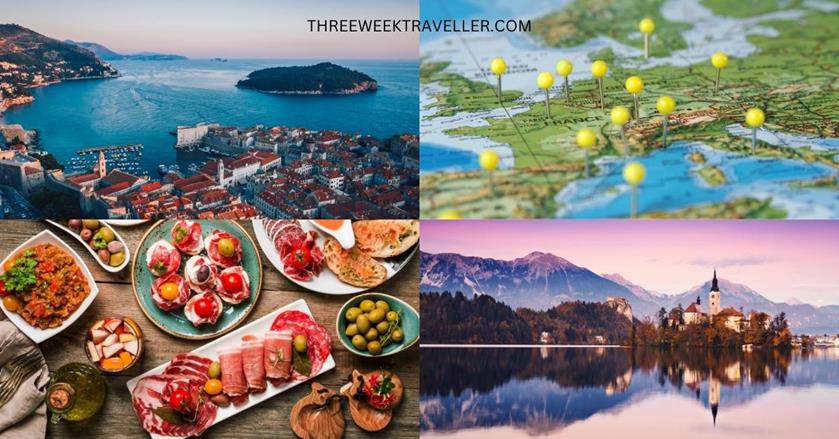
If you plan a trip for 3 weeks in Europe, stay with me as I lay down tips on travelling there on a budget. Decide where you want to go, when, how much you will spend, and what you plan to do once you go there.
I created a detailed outline to help you plan your 3-week Europe trip or you can also consider a 3-week cruise around Europe.
Where to go in Europe for 3 weeks
If you want a hassle-free trip, y ou could visit countries that share land borders or are near each other. You can also limit your visit to 3 countries to spend at least a week in each.
For example, France, Italy, and Spain are super popular and are easy to get from one to another. The same goes for Norway, Denmark, and Sweden. The Baltics (Lithuania, Latvia, and Estonia) is another example of Hungary, Croatia, and Greece/
That way, you could experience what each country offers without rushing. You wouldn’t be overwhelmed by the new cultural experiences and frequent environmental changes. You should check our compilation of 3-week travel itineraries for different (each) European countries .

When to go to Europe
This actually depends on what activities you want to do. For instance, summer would be perfect if you like swimming , various water activities, open-air concerts, and museums. If you’re going to try skiing, ice skating, sledging and see frozen waterfalls and snow in general, you should go during winter.
You can go hiking in spring and discover diverse flora and fauna along the way, as most flowers bloom during springtime. Europe also has various music and cooking festivals, while during fall, you can attend their world-famous festivals, enjoy the changing of the tree colours, and do lots of hiking and museum visits.
However, if you ask me, I like visiting Europe during late spring or late autumn, from March to April or September to October. These are shoulder seasons; the weather is neither too hot nor too cold, there are fewer tourists, and accommodation prices are a bit lower.
Check our list of best destinations to go for a beach trip and t op places to spend winter for 3 weeks .
You don’t have to write your itinerary from start to finish, day by day, but writing some sort of guideline will help you visualise your trip. You can check which destinations you can afford to book a private room and which places you have to book dorm rooms.
Y ou can join free walking tours in Europe, which are widespread . The great thing about this is that you only need to give a tip to the tour guide according to your satisfaction. You can also take local transportation such as trains, buses, or subways (they call them metro in Europe).
You can also check if you can rent bicycles. This means of transportation is enjoyable, and you would be able to appreciate the places you visit more when riding a bike.
Another way to save money when taking public transportation is by booking a shared ride (either from your hotel to the airport or the following city/country).
Pack lightweight
There are so many cheap flights across Europe, but the catch is that the baggage cost on flights often doubles the ticket costs.
That’s why you need only to bring the essentials and pack light. In this way, you also could move faster because you don’t need to rearranging your belongings or drag a heavy suitcase or backpack.
We have an amazing packing list for general travel , which comes with a free printable checklist. You can also check our packing list for summer or the packing list for winter .
Basic travel tools and sites
When planning your trip, check different sites for the most affordable and budget-friendly travel services, such as flights, accommodations, and even travel insurance. If your trip is not final, look for sites that offer flexible cancellations if anything changes.
For those sure of their trip, booking your hotels and flights in advance is best to have more options, especially affordable ones.
These are the websites and tools I personally use when booking my trip. The ones I book right away are flights (for international/intercontinental), hotels (to find the best deals), and car rentals.
3 WEEKS IN EUROPE AVERAGE COST
On average, one person should plan around $2,000 for 20 days in Europe . You should be able to stay in a private room and eat out most of the time. But that still depends on where you plan to go.
If you’re on a backpacker’s budget, you should be able to do it for $1,500 . Plan to stay in dorm rooms and cook when you can.
If you want to splurge, $4,500 for 3 weeks in Europe is very comfortable. You can book five-star hotels, eat at fancier restaurants, and book private tours.
Pro tip: Don’t include your airfare when computing your budget because airfares change drastically . You can also try to book during non-peak seasons to save more or wait for promos.
When computing how much a 3-week Europe trip costs, you should consider food, accommodation, and tours. Last-minute bookings are the most expensive. Hence if possible, book as early as three months before your planned trip.
How much is it really to travel to Europe for 3 weeks? It depends on the person, of course. However, personally, I spent about $1,200 on one summer. I also visited during winter, where I paid $1,000 in 3 weeks, mostly because I decided to head to East Europe . I also backpacked around for three months and spent about $2000.
In my opinion, Europe is not that expensive compared to North America or even Oceania. But it would help if you had a good plan and were okay with not always eating in fancy places. The great thing about Europe is the hostel community, it’s affordable and a great way to socialise.
I mainly stayed in hostels around Europe, took public transportation, walked a lot, ate street food and went to local grocery stores. I also made sure to see as many places as possible and enjoy some “luxury” here and there.
You can also book this 7-day tour of central Europe , which covers Germany, Czechia, Slovakia, Hungary, Austria, and Switzerland. Transportation, accommodation, tour manager, and breakfast are all included.
PINNED MAP OF DIFFERENT ITINERARIES
Click the enlarge button on the top right corner. Credit: map data: Google
EUROPE IN 3 WEEKS ITINERARIES
I created a list of various destinations according to season and budget preference. I included itemised lists of how much a 3-week Europe trip costs so you could know what you could do with specific budget ranges. Please note that this budget is for one person only, and you can adjust the cost according to the number of people.
>> We also have an article on affordable destinations to spend your 3-week vacation
Most Affordable Winter Destination – Portugal, Spain, Italy
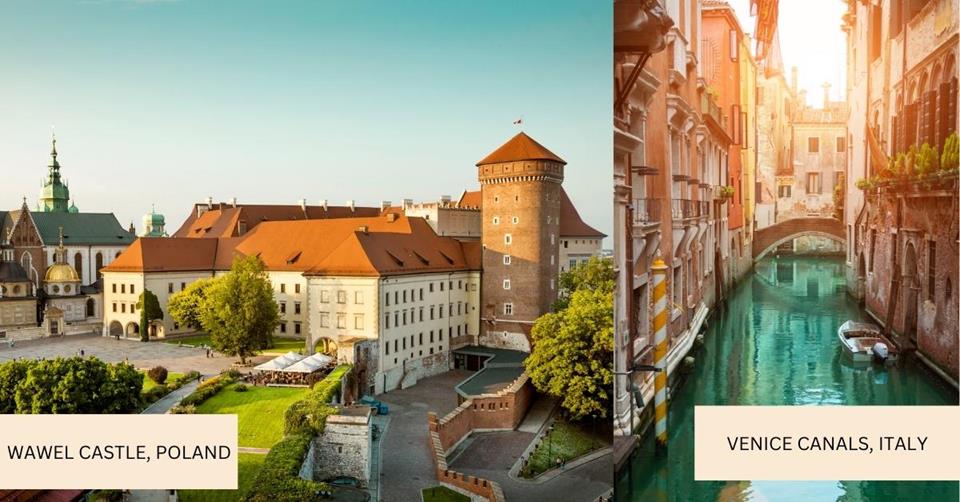
If you want to visit Europe during winter, consider visiting Portugal, Spain and Italy. These three are close to each other. They also have affordable accommodations and generally have fewer tourists during this season.
In Italy, you can enjoy the Colosseum without crowds , explore the mountains, and spend time in museums. You will also have the luxury of spending the entire 3 weeks in Italy , covering north to south. From mountains, vineyards, and historical places, to Mediterranean beaches. If you are foody, you definitely have to try these best Italian desserts .
On the other hand, Portugal doesn’t suffer from freezing temperatures even in the middle of the winter season, so you can still enjoy the sunlight and do various outdoor activities such as hiking. There are popular Instagrammable spots in Portugal that are worth a visit, and of course, wine and food.
You want to see Porto and Lisbon, especially if you want to hike the popular Santiago de Compostela route. Once you get to Porto, stay near a bus or metro stop, both budget-friendly ways to move around. If you don’t know where to stay in Porto, near the historic centre of Ribeira District, both offer affordable options.
Don’t forget Lagos; it offers such wonderful water activities. This is an incredible destination if you plan to visit during summer. Lagos is located in the Algarve region, a popular area for its coastal features. If the water is too cold during winter in the Algarve, there are other things you can do, such as hiking, visiting chapels, enjoy a road trip.
If you are heading to the capital, decide on the activities, from museums, beaches, hiking, and even night-out parties. Knowing what to pack for Lisbon will ensure you don’t waste your time and money. Check our itinerary for 3 weeks in Portugal .
Lastly, Spain holds some of the best festivals on the continent during this season . During winter, the best places to visit in Spain are Seville, Barcelona, Madrid, Granada, the Canary Islands, and Costa del Sol.
There are so many places to see in Madrid, and probably a good 5 days here is the perfect spot. At the same time, Barcelona for 2 days will allow you to cover too many attractions.
But please, do not miss the Canary Islands – like no other in Europe. We have 3 weeks in Spain. Below are the budget ranges you should allocate for food, guided tours and accommodation. You can also check out our 3 weeks in France, Italy, and Spain itinerary .
- food budget per day: $20
- guided tours cost per day: $15-$30
- accommodation cost per day: $25-$45 as a backpacker or $70+ for mid-range
- 3-week budget: $1,200-$1,800 (excluding flights to and back)
Mid-range – UK, France, Germany
If you want to spend more, visit the UK, France and Germany. These countries are rich in history and are close to each other, so much so that you can take trains to cross borders. They also have great wine and beers, so this option is perfect for wine and beer enthusiasts.
Check out our 3 weeks in Central Europe itinerary, which features Germany, Poland, Czechia, Switzerland, Austria, Slovakia, and Hungary. But if you prefer the West, we also have an itinerary for 3 weeks in Western Europe or a sole 3 weeks in Germany post.
If this is the region you want to visit, it’s best to come during the off-season, which is either from March to May or September to November. The prices are lower, and there are fewer crowds.
If you visit the UK, you can finally see Big Ben in London and London Bridge . You can spend your holiday in England, which hosts festive Christmas markets and drink hot chocolate while wandering about or seeing the world-famous Isle of Skye in Scotland.
There are many ways to explore the UK. We have a guide for 3 weeks in England only, or you can also explore the entire country and do 3 weeks in the UK .
However, if you have been to the UK before, you probably want to visit Ireland this tim e. You can combine Scotland, Northern Ireland, and Ireland. Please look at our 3 weeks in the UK and Ireland itinerary .
In France, you can take a picture of the Eiffel Tower or visit the Louvre if you’re a museum enthusiast. You can also try out their seasonal cuisines and go on a shopping spree as they have a government-mandated citywide sale during this season, also known as “soldes”. And yes, we have an itinerary for 3 weeks in France .
In Germany, you can go to thermal bathhouses to experience their outdoor pools and saunas . You can also ride their historic cable car, Merkurbergbahn, to see the snow-covered pine trees. Here are the daily price ranges for food, accommodation and tours.
- food budget per day: $25-$35
- guided tours cost per day: $30-$50
- accommodation cost per day: $35-$50 for backpackers or $80+ for mid-range
- 3-week budget: $1,900-$2,800 (excluding flights to and back)
Affordable Summer Destination – Italy, Croatia, Greece
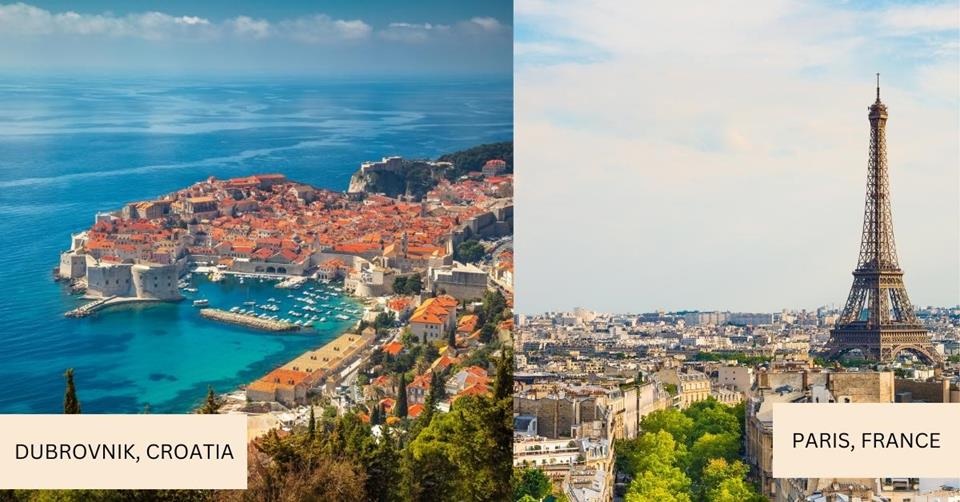
For affordable summer destinations, Italy, Croatia, and Greece are must-visits. They are not necessarily next to each other or affordable. Italy is expensive, but Greece and Croatia are a bit more affordable so that balances it out.
Another thing is that flights between these three countries are affordable. Plus, it’s in Southern Europe ; there’s no better place for a beach vacation in this region.
These 3 destinations serve great food, wine, and beer and are rich in natural scenic spots like beaches and mountains. Personally, I would say this is the best way to explore Europe in 3 weeks on a budget.
Italy is known for their fantastic food. You can go on a gondola ride in Venice and have wine tastings in Sorrento, which sounds like a perfect summer getaway. Venice is not really a budget-friendly destination.
But, if you want to make this trip affordable, check out the coastal cities on the southeast side of Italy. Not only are they cheaper for vacation in this expensive country, but they are also less crowded.
Greece is a famous summer spot as well. You can visit Mycenae, an ageless arch made with monumental stones that was once a dwelling place of some of the most famous people in Grecian history, including Agamemnon, Electra, and Orestes. You can also have a road trip with your friends around Pelion or just chill and have a slow day in Hydra.
This country is an excellent choice if you want to experience the Mediterranean Sea but want to do Europe in 3 weeks on a budget. 3 weeks in Greece is a little more affordable than Spain, France, and Italy.
Croatia is now known for its location in Game of Thrones, but it has more to offer. You can go coral diving during the summer season. You can also avail yourself of a boat trip, hike, swim, cycle or sail; honestly, the sky’s the limit with the number of things you could do here.
It’s another more affordable destination but located ion on the Mediterranean Sea. You can check our 3 weeks in Croatia itinerary too.
- accommodation cost per day: $25-$35 or $50 and up for mid-range
- 3-week budget: $1,000-$1,800(excluding flights to and back)
Drinks and Beach – France, Poland, Greece
If you are the type of person who wants to lounge along the beach while drinking wine or beer, then this triad is perfect for you . Aside from that, these countries are rich in historical artefacts and landmarks, and flight tickets are cheap.
One of the most famous beaches in France is Plage de la Cote des Basques in Biarritz, which you’ve probably read about in Hemingway’s The Sun Also Rises . Another famous beach is the Deauville beach in Normandy, where Coco Chanel opened her first clothing store and held historical value .
Sopot is one of the most famous beaches in Poland , especially for the locals, because aside from chilling and sipping wine along the bay, you can also take boat rides, and there are spas and saunas nearby.
Swinoujscie Beach is famous for its water sports because of the constant wind and waves. It also has a windmill nearby which is considered its most famous landmark. Greece has the most beautiful beaches in Europe, so you won’t have difficulty looking for a great beach there. Some of the most beautiful beaches are Mykonos, Crete and Santorini.
- accommodation cost per day: $25-$50
- 3-week budget: $1,700-$2,800 (excluding flights to and back)
CHECK-OUT: Best itineraries for 3 weeks in East Europe
A bit of splurge – Iceland, Norway, Denmark
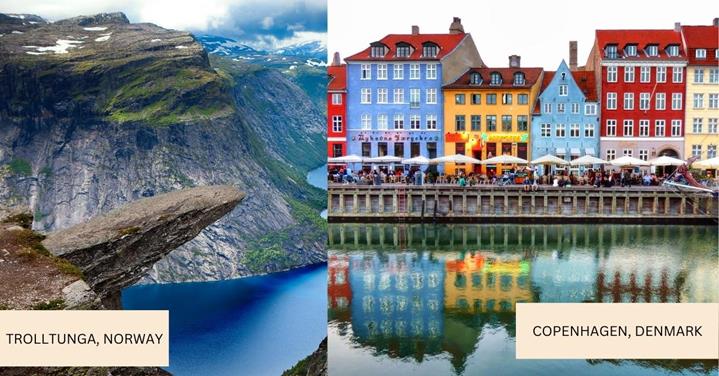
I know Scandinavia or the Nordic region doesn’t scream Europe in 3 weeks on a budget. But if you have a larger budget and want to splurge a little, Iceland, Norway, and Denmark are the perfect places to visit. The best way to make this plan affordable is to rent a car rather than relying on domestic flights, trains, or even buses.
Not super cheap, but it can be affordable if you plan and look for great deals. Remember these tips for visiting Iceland and travelling to Scandinavia for first-time travellers to this region.
You should look at flights and book accommodations 4-6 months in advance . Travelling in the northern hemisphere during the off-season, fall or winter, would be best.
Book hotels in advance to save money and also use local transportation. For instance, if you plan to go during the summer, flights are cheaper if you book them during the winter.
You can enjoy many free or affordable activities like hiking, sightseeing, or road-tripping. You can also enjoy their street foods at a lower price than at their restaurants.
If you are curious, some of the most famous places in Iceland include the Blue Lagoon in Grindavik, a geothermal spa and Strokkur Geysir, where spectacular geysers are found. You can also witness the northern lights if you’re lucky, as the time of their appearance is quite unpredictable.
Meanwhile, in Norway, you can visit the Lofoten Islands or the scenic city of Bergen, which form an archipelago and go to the Lofoten War Memorial Museum. Bygdoy Peninsula is also home to some of Oslo’s top tourist attractions.
In Denmark, you can visit the Tivoli Gardens found in Copenhagen and Nyhavn, the model of most postcards and can also be found in Copenhagen. Here, you will also see the statue of the Little Mermaid, yep, that story was written by the Danish writer, Hans Christian Andersen.
Do you know that you can spend 3 weeks in Scandinavia and cover Norway, Denmark, and Sweden on the same trip? We also have 3 weeks in Iceland itinerary if that’s something you have in mind and a Norway itinerary .
- food budget per day: $30-$50
- guided tours cost per day: $50-$70
- accommodation cost per day: $45-$60 for backpackers or $100+ for mid-range
- 3-week budget: $2,400-$3,500 (excluding flights to and back)
The Baltics – Lithuania, Latvia, Estonia
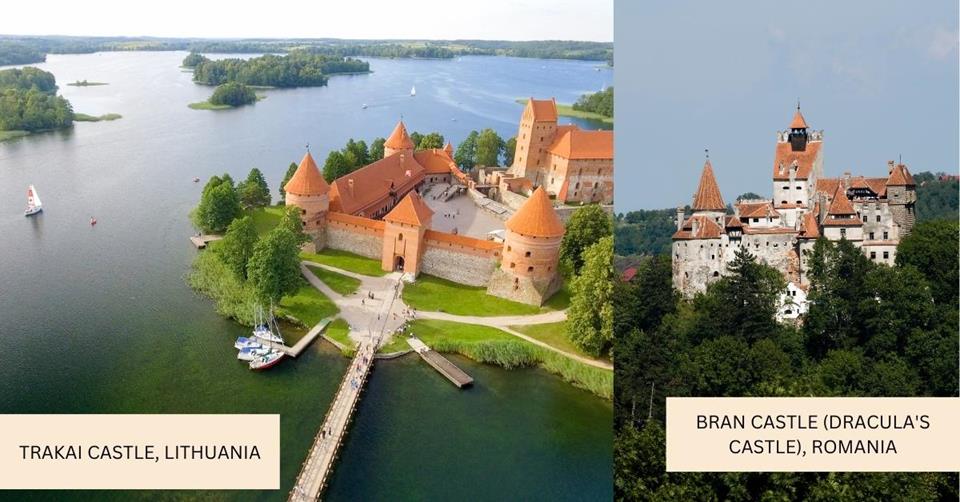
If I’m on a budget, these three countries are my favourite European destinations for Europe in 3 weeks . These places offer a calm and relaxing vibe, from beaches to hiking, to castles, without spending too much.
You can cross the borders via train or bus, saving you money instead of flying. I’m not going to lie. The Baltic beaches are not stunning, but they offer a tranquil scene and few tourists.
I recommend you enter either through Vilnius or Tallinn and make your way north or south. Don’t forget to try cider from this region. It’s one of the best in Europe. Few do this, but road-tripping through the Baltics is the best way to explore this area. It’s more affordable and gives you so much more freedom.
In Lithuania, make sure to visit Vilnius, Kaunas, and Klaipeda. These two cities offer different activities from one another. Vilnius for the cultural and historical experiences and the best nightlife in Lithuania. In comparison, Kaunas is known for its creative and street arts.
Even though it’s a small city, many things to do in Kaunas are related to art. Last but not least, Klaipeda for the beach and other water activities. Make sure to visit Trakai Castle and Uzupis.
From there, make your way to Riga, the coastal capital of Latvia. Enjoy museums, castles, fortresses, and the beach during summer. You can also visit Rezekne, where Raznas National Park is located. Here, you can enjoy hiking, fishing, and even canoeing.
And lastly, Tallinn. A vibrant and modern city, Estonia’s capital and known for being the leading digital powerhouse of the Baltics. Estonia is the pioneer of digital residencies and the first country to welcome digital nomads. Many museums show Estonia’s history and culture. Being on the coast, you can enjoy the beach during warm weather and other water activities.
- food budget per day: $15-$30
- accommodation cost per day: $35-$50 for backpackers and $60+ for mid-range hotels
- 3-week budget: $1,400-$2,300 (excluding flights to and back)
SUMMARY OF EUROPE IN 3 WEEKS
Europe might be expensive in general, but with enough planning and research, you should be able to create a travel plan for Europe without spending too much.
Our own guide to Europe in 3 weeks on a budget, consists of our personal list of places that I visited and perhaps you can visit them as well depending on your budget, season and activity preference.
These budget ranges are for participating in group tours and eating in bazaars, holiday fairs or mobile food carts instead of going to fancy restaurants.
Next summer, I plan to be in Europe for 3 weeks visiting Italy (can never get enough!, Slovenia, and Czechia.
We hope reading this has been enjoyable and informative for you as much as compiling this list has been delightful. We also hope you would consider going to Europe because there are many famous scenic spots and hidden gems just waiting to be visited.
SAVE THIS TRAVEL ITINERARY ON YOUR PINTEREST:
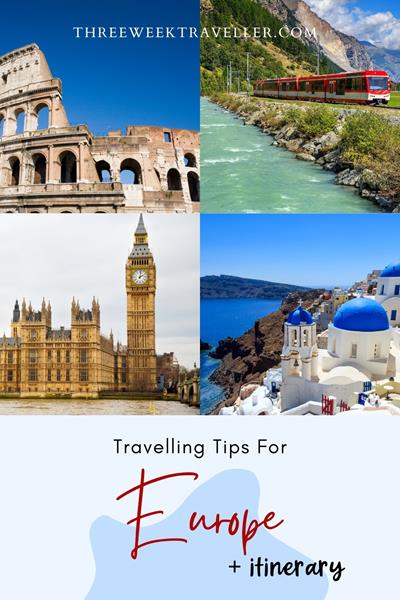

Accommodations
As you can imagine, your Europe trip cost will vary greatly depending on your style and where you visit. I recommend budgeting $150 a night for your hotel, which works out to $2,100 for 13 nights. From hostels to luxury hotels, Europe gives you many options to easily find accommodations that fit your budget.
If you’re backpacking through Europe, hostels will probably be your choice of accommodation. If you decide to go that route, the average price is $15 – $20 a night. Alternatively, there are a lot of great boutique hostels out there that cost more but offer a better experience since they’re competing with hotels and Airbnb.
Recommendations: YHA London Central (London), Barnacles hostel (Dublin), The Flying Pig Uptown (Amsterdam), Goodmorning Hostel (Lisbon)
Mid-range hotels
For those who think $150 is expensive, I would argue that it’s on the cheaper end. The reality is that hotels are expensive these days, so getting one for $150 a night is a pretty good deal. Remember, this is just an estimate. In some European countries, some hotels will cost you more while others will cost you less. You can also follow my guide on how to save money on hotels .
Recommendations: Alhambra Hotel (London), Stauntons on the Green (Dublin), Hotel Nicolaas Witsen (Amsterdam), Hotel Excelsior (Lisbon)
Luxury hotels
There will likely be luxury hotel options regardless of what city you’re visiting. If you like the experience or don’t mind spending the extra money, you may want to budget another $200 – $300 a night. Your Europe trip cost will skyrocket if you’re going for luxury stays.
Recommendations : The Langham (London), Clontarf Castle (Dublin), Amsterdam Marriott Hotel (Amsterdam), Iberostar Lisboa (Lisbon)
Depending on the city, I sometimes prefer to use Airbnb. I’ve been able to find private apartments in good locations for about $100 a night. If you’re travelling with kids or family, Airbnb can be a great deal since you should easily be able to find a space that fits your entire party. I do admit that Airbnb has become more expensive over the years, but it’s still a good hotel alternative.
If you have the right credit card, you can save a fair amount of money on hotels. Americans should strongly consider the Marriott Bonvoy Brilliant American Express Card since you can earn up to 95,000 Marriott Bonvoy points and $300 back at U.S. restaurants as a welcome bonus . Canadians should consider the Marriott Bonvoy American Express , which gives you up to 75,000 Marriott Bonvoy points. That’s enough points for a few free nights at some hotels, which could easily have a value of over $500.
Local transportation
Since I assume you’re doing thee cities during this trip, you’ll need to factor in flights and/or trains to each destination. I’m also assuming you’re booking a multi-destination ticket, so you don’t need to backtrack. Realistically speaking, budgeting $400 for location transportation may be a bit high, but remember, you must also pay for trips to/from the airport, day trips, and any other public transportation you use.
Generally speaking, getting a Eurail pass won’t be worth it if you’re in Europe for just two weeks and visiting three cities/countries. If you’re going to neighbouring countries or taking day trips, buying tickets as needed is fine. That said, buying your train tickets well in advance (even before you depart) is usually worth it, as you’ll get better prices and a confirmed seat.

Attractions
This is where things can get tricky. Attractions aren’t expensive, but if you keep going into them, you will naturally spend more. First off, always do the free things in every city. That means checking to see if any museums or art galleries have no entrance fee. Note that even museums with an admission charge (including big, famous museums like the Louvre Museum in Paris) usually have a free day, so you must see if the timing works out.
Parks are always free, and quite often, simply walking around neighbourhoods is the best way to see a new city, and that doesn’t cost you anything. In Europe, there are also many free walking tours – well, you need to pay a tip – but that’s a cheap way to learn about the city.
Finally, check to see if museum passes will help you save money. Many cities offer something such as free entry into a bunch of attractions for a fixed price for a set period of time, e.g. 24, 48, or 96 hours. You would need to do the math to see if the cost of the attractions you’re interested in makes up for the cost of the pass.
If you plan to pay for some attractions or do day trips into the countryside to see some of the local landscapes, check to see if Klook sells tickets. Buying your tickets in advance usually means you can get a small discount and skip the lines when you arrive.
Food and drink
The food and drink budget will vary by person, but a rough estimate for a meal, including drinks is as follows:
- Breakfast – $5
- Lunch – $10
- Dinner – $30
That works out to $45 per person per day, which some people think is too much, while others think it’s too low. If you like to drink alcohol, you’ll need to budget more. What I personally try to do is balance eating street/fast food with restaurants. I also go to grocery stores to get breakfast and snacks, which saves me a lot of money. Cutting back on eating out will help you see Europe on a budget.
Every city and country you visit will have some local delicacies which I highly recommend you try. To this day, I’m still mad at myself for not having tapas in Spain because I thought it was too expensive. I’m not suggesting you blow your budget on food, but it’s okay to splurge occasionally. Even then it doesn’t need to be fancy. A baguette and cheese in Paris is pretty cheap but also delicious.

Random spending
Many people forget to include shopping when planning their vacation budget. It’s silly to think that you’ll spend nothing on random things; you’ll buy gifts for people, right? Plus, you’ll want to pick up plenty of souvenirs for yourself, regardless of how tacky they appear. There’s nothing wrong with buying gifts for yourself or friends; you just want to make sure you budget for it.
As you can imagine, some cities have better shopping experiences than others, so you must consider where you’re going and budget accordingly. For example, you may be headed to Italy and intend to buy a leather purse. There’s nothing wrong with that. Just make sure you’ve set aside some money for that purchase.
As a general rule, you should set aside $200 or 200 Euros for those random expenses that come up. Heck, even spending some extra money on sightseeing can be worth it.
Cost to go to Europe
So how much does it cost to go to Europe for two weeks? You know the answer – it depends! But, a good estimate is about $4,280. One time I spent just $2,300 because I focused on doing it for as cheap as possible. Another time I spent closer to $8,000 (for two people) when visiting just three cities. The cost of a Europe trip depends on you, but it’s not hard to stretch your travel budget.
For more European inspiration, check out my guides to Scotland , Italy , Croatia , Austria , Malta , Greece , and Amsterdam on a budget .
Frequently asked questions
Is it possible to see europe on a budget.
Absolutely! But it will take some planning. The biggest thing to remember is what countries or cities you visit. Places like London, England, Paris, France, Copenhagen, Denmark, and Florence or Milan in Italy will cost a lot more than places like Romania, Poland, Bosnia, Slovenia, and even Croatia. There are also several other ways to help cut costs and see Europe on a budget, even in the pricier destinations. Take a look at my Europe on a budget article for more tips and advice on how to see and do more for less.
Is it safe to backpack Europe?
Generally speaking, yes. This is somewhat of a blanket statement as Europe is a huge place and different countries and even cities will have some not-so-savoury places that are best avoided. But that’s the same everywhere. Some cities are very backpacker-friendly, such as Berlin, Zagreb, Luxembourg, and Munich.
You should be fine if you travel smart, follow basic safety protocols, and trust your gut. At the end of the day, use common sense. Don’t go to a bar with strangers and get black-out drunk. That’s not a good idea anywhere.
If you are uncomfortable or unsure about doing it yourself, you can always book a package tour or even a cruise. However, these will dramatically increase your costs and don’t allow for as much flexibility.
Are rail passes worth it?
It depends. Rail passes, such as the Eurail Pass , can be great because they take out a lot of planning and leg work and make it easy, but you pay for that convenience. Oftentimes there are more affordable transit options that are just as comfortable. Many countries have slower local trains that you can take advantage of. In some places, like Ireland, the bus system is better connected (and cheaper) than trains, etc.
If you are trying to figure out how much does it cost to go to Europe because you are on a tighter budget, it’s worth taking the time to do a bit of planning and do it on your own. If money isn’t an issue and you are more concerned about convenience, then a rail pass might be worth it for your Europe tour.
What are some fun things to do in Europe?
Europe is a popular destination for North Americans because it’s so different from here in many ways. The history and architecture are incredible; it’s wild to think some buildings are centuries older than Canada. Food is another huge perk to travel in Europe. It’s so varied across the continent, and while we have plenty of food options from different cultures in Canada and the USA, it’s always better from the source.
You may also be interested in visiting Europe for specific events. Perhaps St. Patrick’s Day in Ireland, or Carnival in Venice, or the Christmas markets of Germany. Don’t worry about finding things to do in Europe, and there’s plenty.
What are the best places to visit in Europe?
This depends on your interests. Are you interested in history? Maybe cities like Berlin and Vienna will be the most interesting for you. Love art? Perhaps Paris is the best option. More into beaches and nature? Try Croatia. Some people have dreamt about the canals in Venice and the Leaning Tower of Pisa, so they make Italy their priority.
What are the five most important tourist attractions in Europe?
It depends on your likes and interests. What is interesting to me might not be interesting to you. That being said, the most popular tourist attractions in Europe include:
- The Eiffel Tower in Paris
- The Colosseum in Rome
- Neuschwanstein Castle in Germany
- The Acropolis in Athens
- Stonehenge, England
- Aurora Borealis in Iceland
What are some unusual things to do in Europe?
Europe has plenty of weird and wonderful things to do that you wouldn’t necessarily find in North America. A few recommendations include the following:
- Visiting Sedlec Ossuary just outside of Prague (It’s made of human bones)
- Eat haggis in Scotland
- Attend a Krampus Run in Austria (Krampus is essentially a Christmas demon that kidnaps and tortures children. Like an anti-Santa)
When is the best time to go to Europe?
This can depend on your goals and the destination itself, but generally speaking, the shoulder seasons (September/October and April/May) are great. It’s not too crowded, the weather is pleasant, and you can avoid peak season costs.
How long can I stay in Europe?
While many backpackers love to do European tours, you need to be mindful of the amount of time you are allowed to spend not just in a specific country but in an area. Many European countries are part of the Schengen Zone, and Canadians and Americans can only spend a total of 90 days within a 180-day period in these places. Examples of Schengen zone countries include Austria, Netherlands, Spain, Poland, Italy, Iceland, and more.

About Barry Choi
Barry Choi is a Toronto-based personal finance and travel expert who frequently makes media appearances. His blog Money We Have is one of Canada’s most trusted sources when it comes to money and travel. You can find him on Twitter: @barrychoi
128 Comments
Great post. Our vacation plans for this year is to go to Denmark and Sweden. I heard that Scandinavia is really expensive. I found airline tickets for $1,600 for 2 people. Still looking for accommodations at Airbnb. My plan is not to go over our budget of $5k for our 11 day trip.

I’ve actually heard Scandinavia is expensive so let me know what the real costs are after. The good thing is, flights to Scandinavia have never been cheaper. You can get cheap flights if you fly via Iceland and I’ve also seen cheap airfare on Noreweigian.
Hi Barry! I’m planning an all girls trip (around 6 girls) to Europe from Pakistan. Which countries/cities would you recommend? Also we all have a budget of $2500 per person. Do you think it would cost less on accommodation as the cost would split? And would love if you can give some tips?
So I recommend talking to your girlfriends and asking what cities/countries they’re most interested in first. From there, you can try to figure out logistics. Your flights will be the biggest expenses. If you fly into one city and out of another, you won’t need to backtrack. E.g. fly into Paris and out of London.
As for accommodations, since there are 6 of you, you could look for a hostel that has rooms for 6 – 8 with a private room. If you buy out every bed in the room, you’ll have the entire place to yourself. That will likely be cheaper than getting 2-3 hotel rooms each night. You could also look for an Airbnb that accommodates 6, but that might be tough.
$2,500 a person is doable (depending on the destinations) and how long you go for, but I always recommend budgeting extra. This sounds like a really fun trip for you and your friends, the last thing you want is to be watching your budget the entire time you’re there.
Hi I’m from south Africa and I’m looking to travel to barcelona for 2 weeks.
I’m a student so I’m looking for as cheap as possible but I dont want to miss out on anything.
I have a friend living in barcelona so accommodation is already paid for which is a big expense luckily.
We are looking to travel to Greece and Amsterdam during this time.
Was wondering if I take 2000 euros if that would be enough for the two weeks.
Kind regards Jonathan
Hi Jonathan, if you’re staying at hostels or inexpensive accommodations when you’re in Greece and Amsterdam, that should be enough. I’m assuming your flight isn’t part of that 2000 Euro budget.
Nice post but the airfare costs seem to have gone up from your estimates.
Lowest price to Germany from Toronto was $1000 and that was a deal where you are estimating $850 CDN. Plus $200 travel insurance.
Hey Heather,
Yes flight prices have gone up this summer. I expect them to drop during the fall, but I haven’t researched it thoroughly yet.
Thanks, Barry! You always have the best budget/travel advice 🙂
[…] is one of few places that actually has a decent choice of accommodations that won’t burst your travel budget. Hostels are always a favourite among solo travellers, and there are plenty to be found around the […]
I know this is a little old of a thread. I was able to backpack europe with a friend, and only staying in Airbnb. 980$ is what was spent on lodging. We were gone for 4 weeks. The total trip was $5,000 which included souvenirs, trains, rental cars, ferries to the Greek Islands and 4 flights. Two were one way tickets from JFK to Paris, then London to JFK. One of the flights was also $400 from Croatia to Greece. Some of the trains and ferries were accidentally booked first class (which after doing so, I recommend).
Thanks for sharing. Europe can definitely be cheaper if you want it to be. My prices were rough estimates with hotels in mind instead of Airbnb. I love how travellers can see Europe on any budget and as you mentioned, they may still get the luxury experience unintentionally.
Thanks for putting this site togehter. Im planning for a trip to Budapest and Athens, 1 week each, the first 2 weeks of October. Is it still tourist season at this time? Some say prices only drop mid way or end of October. Can you confirm or deny this?
October tends to be slower for Budapest, but depending on where you go in Greece, parts may still be busy since it’s now cruising season in Europe
Thanks for the rapid response, I’m planning on Athens since I’m greatly interested in the historic sites. Not going to any islands like Crete, Rhodes etc. Also out of interest a question if you don’t mind: do you think the recent economy stabilisation (although it probably won’t last long) will change the price of visiting Greece?
Generally speaking, October is the lower season, but since Athens is so popular, it’s not like you’ll see NO tourists, it’ll still be busy. As for their economic situation, I don’t there will be much change as their economy has been tanking for years without prices at hotels or restaurants falling.
I am planning a Euro trip from Canada. I am intending to visit Croatia, Amsterdam and France if possible London. My budget for me and my wife is 7000 USD.
Any advise is much appreciated. Such as where to start and end must visit places and best time to go.
With that budget, you should have no problems seeing those countries. London, Amsterdam, and Paris are quick train rides away from each other. Although Amsterdam and London can be a bit pricier, during the fall, you shouldn’t have many issues finding a reasonably priced hotel. Paris can be inexpensive if you choose a hotel outside of the main areas, just find a place near the metro.
Adding Croatia gets a bit tricky since it’s not really close to the other countries. THat being said, you can find discount air carriers from London, Amsterdam, or Paris to get there. Most people who visit Croatia see more than just one city which is why you need to decide how much of the country you want to see when planning your trip.
Hello! I’m planning out a ways (gives me something to look forward to) for Europe in spring, 2021. We’ll start at a friend’s relative’s in the Black Forest, then on to Paris by train, then Italy by train. Goals are Rome, Florence and Venice. I’m very excited, as I’ve never been to Europe. With staying free the first few nights in Germany, and then four of us sharing AirBnbs, I’m thinking (depending on airfair) that we might be able to do this for around $2,500 each. That’s the goal. I love the idea of looking for special food everywhere we go. In Puerto Rico, we ate the fried plantains, and I enjoyed those. Not sure what tapas is, but hope you get to go back and eat it!
That sounds like a reasonable budget since you have some of your accommodations covered. As for tapas, it’s basically small plates meant for sharing. I actually went back to Barcelona earlier this year and splurged on tapas this time around. It was worth it!
Good for you. Thanks for the tips. Anne
Hi there, I’ll be visiting Europe for 9 days in Feb-Mar flying directly from Newark to Rome, from there to Paris and end the trip in Madrid. On airfare I spent USD 500, in lodging thru AirBnb and hotels a total of 225. I was wondering how much money should I expect to spend on attractions and food? Note: the amount mention above is per person and we are going to be 6 people in total. Note 2: thank you for reminding me to have a category of random expenses!
How much you spend on food is really up to you. Generally speaking in Rome you can get takeaway pizza, sandwiches, or pasta for 5 – 7 Euros per person. Sit down places will probably cost you 10 – 15 Euros per person. I rented an apartment when I was in Rome last and saved a bunch by stocking up on water, drinks, and alcohol from the grocery store. That being said, food in Rome is EXCELLENT so you could easily end up spending more if you want to try more things. I ate gelato twice a day because it was so good there. I wasn’t even hungry, I just wanted it! I STRONGLY advise checking yelp or tripadvisor before dining at any restaurant as the quality can vary quite a bit. Be sure to ask your host for recommendations.
The costs in Paris will likely be similar to Rome, probably a little cheaper (wine is cheaper than water). I haven’t been to Madrid so I can’t comment there, but I would suggest splurging on tapas one day.
Random expenses ALWAYS come up which is why I always budget a little more.
Planning a 10-11 day vacation for family of three( two adults one 7year old) in July 2019 to London, Amsterdam and Paris planning for a 7000 budget. Does this seem reasonable? Round trip from lax to Heathrow are about 2400 planning on doing Airbnb and we are not shoppers. Most likely spend on food, drinks and attractions. First time big vacation so exited!!!!!! Any feedback would be appreciated
That sounds more than reasonable assuming you’re not staying at hotels that cost you $1,000 per night =D. In Paris, it’s easy to find cheaper accommodations. London hotels can be pricey, but there area areas that are more reasonable. Amsterdam tends to be expensive in general unless you stay in Amsterdam SOuth and the take the train into the main areas. That being said, with your budget, you can likely find hotels in good locations.
We are going to Budapest, Kiev, Chisinau, and a couple stops in western Europe (Paris and somewhere else) in June, 2019, for about 23 days. International tickets aside, and with free lodging in Kiev, do you think $50 per person per day is reasonable? Two adults and one 17 ye old are our ages. We are not backpacking and we feel too old to sleep on someone’s couch for three weeks. Thanks for your input.
Does that $50 a day include accommodations? If not, that’s probably way low for an estimate. Food alone will cost you $50 if not more per day. You also need to factor in local transportation, attractions, and any souvenirs you may buy.
Thank you for this article. I am planning an European vacation for next year during the summer, Our trip can be any time between the months of July and August, there will be three of us, myself and my two daughters, 18 and 12. My budget is about 20,000 USD, I´m going to try to make it as long as I can stretch it, maybe 3 weeks, could it be stretched to 4?. I am not sure where exactly to go, I am thinking England, Paris, Italy for now, but that might change depending on where we can fly in and out of the cheapest. I guess my questions are, given that summer is the most expensive time to travel, which cities would you recommend traveling into and out of? I´m in the east coast. Also, I have read about hostels and I’m aprehensive about using them with my daughters, what is your take on them? Another concern of mine is traveling with my daughters, with me being a woman, are there any cities I should stay clear off because of crime? Any help, guidance is greatly appreciated! Thank you!
Hi! Im playing on going on a 16 day eastern european trip to several countries with a budget of around $2500-2700. I plan to save a lot by going to grocery stores and using airbnb. However, I will be going in the wintertime when the world junior ice hockey championship is so the tickets of a couple games might cost $50-100. Is this a reasonable budget for 1 person?
It can be done, but your flights and accommodations will eat up a lot of your costs. It also depends on how many countries you plan on going to. If you’re going to do Airbnb, try renting a private room as opposed to a private apartment since they’re cheaper.
Is it reasonable to expect to find a ticket to Greece or Italy for the $650 estimated price if we book now for July? I haven’t flown much so not sure, but looking at prices from US on Google seem to be more in the $1000-1500 range. Do I just not no where to go for a reasonable deal on a ticket? Any help is appreciated.
July is the summer so prices tend to be higher. For whatever reason, it’s usually a bit more expensive to fly into Greece as opposed to other destinations within Europe. It might be cheaper to fly into a major hub such as London or Amsterdam and then catching a discount carrier from there.
Note, sorry, I just realized I commented on the wrong place before. I apologize.
That budget is pretty healthy so I think you’ll do alright. Here are some things to consider. Have you talked to your daughters about where they want to go? It may be worth letting each daughter choose one destination or country ad then you pick one. That will give you three spots to build your itinerary around. I do believe you could stretch our your itinerary to 4 weeks as long as you don’t go all out on everything. That being said, even at $250 USD per night for hotels, you’d only spend $7,000 for 28 nights.
Figure out your destinations first and then you can work out flights. Getting to Europe will be more expensive in the summer, but getting around once you’re there is realtively inexpensive due to discount carriers.
Hostels can be okay to save money, but again, your budget is quote high so you’d be better off getting a hotel. ALternatively, Airbnb can be a great option for 3 people. That being said, some hostels have private rooms that sleep 4 and have their own bathroom so they might be worth considering. I just think it would be better to use Airbnb.
As for crime. I don’t think it’s fair to say one city is more dangerous than the other. You should obviously do some research about local scams and find out if certain areas are less safe than others, but use common sense when you travel e.g. don’t show off valuables, don’t walk down dark streets alone.
Thank you for your quick response! I will definitely ask my daughters to pick a city/country they want to visit, and then go from there. I´ll also be reading more of your posts to help me along, and will be asking you questions as well,
Hi, I am trying to plan a 15 day trip (not counting 3 days for travel to and from the United States). We want to spend 3 days in Amsterdam, take a night sleeper train to Munich on night 3. Spend maybe a half day exploring Munich before heading to Italy for 5-6 days. From Italy we want to travel to France for 2 days. From France we will travel to Spain for the last few days and fly home from there. Its myself, my husband and our teenage children. I will probably only have between $10,000-$11,000 for our trip, our flights would not be coming out of that. Normally when we travel, we do bananas and oranges for breakfast to save money but we’ve only traveled in the US so I’m not sure how that would work. Is a trip like this doable on that budget?
It’s probably doable on that budget, but I think you’re packing in too much. You have 15 days and you want to go to the following:
Amsterdam Munich Italy (where I assume you’ll go to more than one place) France Spain
You’ll essentially be on the road every 3 days which is crazy busy. Based on your itinerary, Munich seems like the easiest destination to drop. I’d also even consider dropping Spain so you can spend more time in Italy and France.
There are plenty of grocery stores in Europe so you can eat for cheap for breakfast if you like.
Hi Berry, thank you for your reply. Originally my plan was Amsterdam, Italy and Spain but the sleeper train from Amsterdam to Germany makes since so we can sleep while traveling so we aren’t really losing time there and my husband wants to see France over Spain and its closer to Italy so I guess Spain is out. Yes in Italy we want to do Venice and Rome.
ALthough you would save on accommodations and technically travel, you’re still adding another destination. Right now you’re looking at:
Amsterdam Munich Rome Venice France
This is all in two weeks. Are you going to skip Florence? How much of France are you planning on doing?
Hello Barry!
My husband and I are planning a trip to Europe this summer around July for two weeks. We’re budgeting about $4000 (or a bit over depending) each person and want to visit at least 4 cities while we are there. Our top picks are London, Amsterdam, Paris, and somewhere in Italy! Is it doable with our budget? And will we have enough time in each city? We’re flying out from LA and wondering where we should start first. I think a lot of people fly out to UK and start there. Would that be the best course? And flights look most expensive in July and August. Will we be able to plan something in June or is that too soon?? (It’s almost April already) sorry I just bombarded you with so many questions. Any help is appreciated!! We’re super excited and want to make sure we get the best scenario for our trip!
I second this question from Gloria please!
We have 14-15 days and right now thinking spain, italy, france. Leaning towards warmer time of year where we can maybe go to a couple beaches. However we are open to weather in 60s or above. How soon in advance should we be booking this trip? Any suggestions would be greatly appreciated!
Yikes, I don’t know how I missed Gloria’s question last year.
With 14-15 days, I personally would stick to three locations at max with maybe a few day trips on the site. You could easily spend 14-15 days in each of the three countries you’ve listed. I personally recommend going with what your top priorities are. If you want beaches, Spain and France are probably your best bets. Maybe start in PAris, head to southern France and then make your way to Barcelona where you can fly home? I would save Italy for another trip where you do that country on its own.
Hello! My boyfriend and I are leaving May 9th and returning on June 5th (27 days). We are going to London (staying with family), Brussels, Bruges, Munich, Vienna, Salzburg, Interlaken, Milan, Barcelona & Madrid. We booked all of our hostels & aribnbs, bought the eurail pass and paid for our flights. How much should we bring with us for food, attractions, etc for those 27 days?
It really depends on how many attractions you want to see and if you’re foodies or not. Many attractions (especially in London are free), but you could also spend 10 – 20 Euros per museum which adds up quickly. Be sure to do your research to see what’s free and pick one attraction in each city that you’re willing to pay for. Food can be cheap if you visit the grocery store your entire trip and make sandwiches, but that gets boring fast. Between the two of you, you could spend $20 – $100 a day depending on what you like to eat. That being said, many hostels offer free or cheap breakfast so you won’t need to buy every meal.
I think we planned on doing a grocery store breakfast, street food for lunch, and a sit-down/casual meal for dinner. Naturally, we are trying to stick to free attractions. We both enjoy doing things on our own but definitely will at some point pay to get in.
I think we were each planning to bring $3,000 for 27 days ($6,000 total). This would be for food, miscellaneous transportation & attractions. Do you think this is enough? We don’t plan on living lavishly but also not living like “bums” 🙂
I truly appreciate your reply. I have been reading your articles and you are fantastic. Thank you for your advice!
Hey Audrey,
I think that’s a great budget and you’re being smart about your meals. One piece of advice, don’t save just for the sake of saving while there. Enjoy this month with your boyfriend. I personally would rather save money at home where I skip coffee/snack breaks and pack more lunches. You should be able to enjoy as much gelato as you want in Italy guilt free.
Don’t forget to factor in spending on things such as local transportation and souvenirs. You won’t spend a ton on that stuff, but it’s something many people forget to account for.
Hi, i’m planing to travel to Europe next year around Easter time with my teenage son for 2 weeks, our plans are to visit Barcelona, Madrid (soccer game) Paris and Italy, i estimated $6000 for our budget , planning on using Airbnb and trains and lot of walk , which it could be the more economic order to visit those countries?
Hi Alexandra,
Booking an award flight for 4 persons is challenging.
Hawaii being a popular vacation destination, finding award seats can be difficult. I would suggest to set up price alerts for Hawaii flights as this is a very competitive route. It’s often a better value to pay for the flight than using miles.
As for Asia, the biggest challenge is to find the transpacific flights. But if you book well in advance and are flexible on your dates you can find 4 award seats in business class on Air Canada to several destinations in Asia. You can also often find availability on Air China if you don’t mind a layover in China. United could also be a solution for some routes via one of their major hubs like Chicago, Houston, Washington or San Francisco. Finally, you can be lucky and find flights on EVA directly to Taiwan as they fly to Toronto, Vancouver and several US cities.
Once in Asia, you will have more options since there are more Star Alliance airlines to choose from including Asiana, Singapore Airlines, Air Nippon and Thai Airways. Finding availability is also easier since there are more flights and some airlines like Singapore Airline releases more business class award seats for short hauls than they release for long international flights.
Note that since Aeroplan search engine has limited capacity for long and complicated itineraries, you will have to search for each leg one by one as one-ways to see if there is availability.
In conclusion, it is possible to make such a trip for 4 people in business class, but it will require a fair amount of preparation and luck!
It depends on where you’re flying from and what direct routes you have available. Paris, Rome, and Barcelona are all major hubs so it might not be that difficult to figure out a route. You also need to factor in if there’s a certain date you need to be in Madrid for the soccer game.
Hi there! I came across this post while trying to research info about traveling to Europe. My 2 friends and I are trying to plan a trip to France, UK, and possibly Austria within 8-10 days in mid-December. We’re trying to figure out about how much the trip might cost for each of us if we are able to stay with people we know at these destinations. We threw around the number $2000-2500 USD, but I was wondering if you even thought this would be possible (esp so close to the holidays)? We are planning on taking in the sites as much as we can, and want to experience the culture of each of these places, yet we want to do it on a tight budget! Would love to know your thoughts and any advice you might have.
It’s possible, but your flight alone would eat up a fair amount of your budget. You also need to factor in the train and flights when you’re in Europe. Food can be cheap, but it can add up unless you’re just eating fast food or getting groceries. Many attractions are free, but there will be ones you want to pay for.
I think it would be tight, not impossible, but I’d personally budget a little more.
Thank you for a quick response! We’ll see what we can do – hopefully the trip will all work out!
I think it’s doable but just note that you’re choosing 4 expensive destinations. In Paris and Italy, you can likely find reasonable accommodations but London and Amsterdam are a bit on the more expensive side.
For two weeks, I think 4 cities is the maximum you can do. If you need to drop one, drop Italy as that country deserves a trip on its own. London, Paris, and Amsterdam are all within train distance which will make your life easier. Where you start and begin depends on what direct routes you have available to you and prices. Once you’re on the ground, it’s easy to get around. Heck a flight from London to Amsterdam might only cost you $110 USD one-way.
June is a great time to go, those cities don’t require too much planning.
Thank you so much Barry! We are so excited! 🙂
I will be in England, France & Scotland for 2 weeks in June. Thankfully, I will be staying with a friend. I’m not into buying tons of souvenirs, and I don’t expect we’ll be eating out much. Planning to go to lots of free museums & walks in London. We will take train into London & Paris. I’ve been reading every bit of advice I can. Thank you for your helpful articles!
Hi Barry, Im planning to go Europe trip 2 weeks.What 3 -4 cities can you suggest.Mostly do sightseeing, eat from grocery stores, staying at budget Airbnb or hostels, Do free stuff as possible.How much should be the cost.Including air fare.i will be going with my husband as our wedding anniversary. Thanks
My article gives you a good estimate of costs with some recommended cities. If you’re trying to do things cheap, you should look at eastern Europe. You also need to consider what flights you have available to you e.g. is it cheaper for you to fly direct to say Paris or Rome? There are so many variables in play that I can’t just give you a blanket statement or estimate.
Hi Barry Thanks for getting back to me. We plan to start from Paris then 1 day in Prague then Rome Italy to finish.I want to visit Amsterdam but this city is a bit pricey.I hope 2 weeks is enough to cover major attractions, try food and wander around.
Paris, Prague, and Rome aren’t close together but you can get to each one by taking discount carriers. You should probably restrict your itinerary to 4 cities at max or 3 with day trips. Every city can be affordable if you stay outside of the major tourist areas and use public transit.
Helpful site! But you don’t say where you are based out of, when you mention airfare costs. Info please! And thanks.
Hey Catherine,
I’m based out of Canada, but with flight prices, I tend to give an average from North America.
Where in North America? Big difference between east and west coast!
The east coast.
Hi Barry, So glad I stumbled upon this article, very useful info and helpful advice. Thank you! I am planning a trip to Europe perhaps end 2020 for my family of 6 (3 adults, 2 teenagers & a 11yo) for 2 weeks or max 3 from Malaysia/Singapore. 1st trip. Staying with friends in Manchester, hope to take a trip to London. Also visit friends in Geneva. What other cities would you recommend? possible for a budget of usd15k? Mainly Airbnb, groceries, some eating outs, buying food stuff home, minimal souvenirs, mainly doing free stuff if possible. Thanks Barry.
If you’re staying in Manchester and you plan on going to Geneva too, I would just look for another stop in between the two via a discount carrier. Paris and Amsterdam are likely cities that fit your route.
I think your budget is pretty reasonable. It’s the flights that will cost you the most.
We are currently living in Dubai. We (with my boyfriend) are planning to do a Europe Tour. Which country would you recommend most? Planning for a 3-4 week vacation. Would love to see Paris,Rome, Amsterdam, London, Norway,and Prague. What do you think? Any recommendations for perfect destination for us? And propose budget for both of us?
If you have 3-4 weeks, you can do quite a lot, but I would recommend to sticking to a route that’s logical and limits the amount of time you’re on sitting on trains. Right now you’ve listed all the major cities but Norway is sort of out of the way. If you’re going to Rome, you should probably check out Florence too.
I would recommend choosing 3-4 MUST SEE destinations first and then building your itinerary from there. I can’t recommend you the perfect destination as I don’t know what type of traveller you are or the type of person you are.
Thanks Barry, appreciate your input.
Me and my husband are planning to visit to Amsterdam, paris and swiss by the end of August 2019 from India. we have no clue how to plan a budget travel as we never been there in europe. please give your input to plan our budget travel. thanks in advance 🙂
Just start researching everything. Look up the cost of flights from India first then start looking at hotels or Airbnb in the destinations you want to go to. AMsterdam and Paris are a quick train ride away from each other, but if you want to go to Switzerland, you may need to fly. Switzerland can be quite expensive.
I am glad I stumbled across your website. I have not travelled much at all and never internationally, but I want to take my daughter, who just graduated from high school to France and possibly Germany in the next couple of months.Can you recommend what cities or areas we should see, definitely Paris, but I wasn’t sure if I should consider other areas? I was planning on probably 8-10 days in Europe. We love history and museums and music (my daughter is a cellist and singer). Also, since it’s just the 2 of us and we don’t have any international travel experience, do you think it would be better for us to stay at hotels or Airbnb?
Thank you for all your great suggestions!
Hi Stefanie,
If this is your first time travelling to Europe, you should ask your daughter what city she wants to see most and build around that. 8-10 days will give you enough time to see two cities with maybe one day trip. If she’s a cellist and singer, perhaps Vienna will appeal to her? Hotels or AIrbnb likely wouldn’t make a difference. Just go with what fits your budget.
Im planning a 2 and a half month, Western Europe trip in summer of ’21 and was wondering, if I am backpacking through France, Germany, Belgium, Netherlands, Czechia, Austria, Italy and Switzerland could I reasonably get by with 10,000? Airfare and a eurorail pass to get around wouldn’t be included. Just wanted to know if I am out of my mind or if thats a reasonable price if Im spending 100 a day, on hostels and food and then would have around 2.5 for a little bit of wiggle room. Just wanted someone who has done this before to get their opinion on it please!
If you’re slow travelling and staying in hostels, that amount will likely be more than enough. Some countries will cost more than others but everything should balance in the end.
This was great and gave me better idea’s on a visit to Europe, thank you very much. I’m a 68 year young woman and thinking about going to see my friend in Portsmouth. I don’t have a clue on budget. I’ve never been to Europe so I thought on a budget of $2000. I could possibly do this for 7 to 10 days staying with my friend of course. I’d like to see a couple of places, Rome and Paris.
That budget is tight and likely wouldn’t leave you much wiggle room. Even though you’ll stay with your friend in Portsmouth, you’ll need to get there first which may eat a lot of your budget depending on where you’re flying from. You’ll then need to factor in flights and hotels in Rome and Paris. There’s also food and attractions to consider.
Hi! I’m looking to plan a trip with a friend from LAX to Switzerland. I found round trip tickets to Zurich for $550 and definitely want to go to Grindelwald (we’re both hikers and Harry’s potter fans). It looks like accommodation in Grindelwald can work out to about $100 per day, so $50 per person. Is that a reasonable budget for Zurich as well? We’re not looking at hotels but Airbnb and hostels. We plan to eat maybe 1 meal a day at a restaurant and definitely breakfast at the hostel or Airbnb. Does a budget of about $1,000 per person for one week sounds reasonable to you? I was surprised while pricing it out that accommodation, travel etc. basically double the cost of the trip. Any recommendations for Switzerland (specifically near the Zurich and Grindelwald areas)?
The above $1,000 is for 6-7 days.
If you’re able to keep your accommodation costs down it’s doable, but note that Switzerland, in general, is expensive. You’ll also need to budget for food, transportation and attractions which can add up quickly.
Really a great article. I need your suggestion on my itenary and budget. I am from India and planning a first time trip to Europe covering 14 countries stating from Turkey to Greece (10 days), Italy(10 days), Paris (only) 5 days, Swizterland(4days), Luxembourg 3days, Belgium 4 days, Netherlands 4 days, Austria 7 days, Budapest 3 days, Prague 3 days, Denmark 3 days, Sweden 3 days, Norway 5 days and finally 10 days in Iceland. A total of 75 days in Schengen Area. and 5 days in Turkey. Me and my wife and our 1yr old son will be doing this trip and I plan to start in March 2020. My budget is 13000 Euros. I am planning on getting a EU global pass most of my europe travel will be in trains apart from a few places like India to Paris, Iceland to India and Athens to Venice, etc and staying at airbnb everywhere I go. I also want to do food cheap apart from eating/tasting local delicacies once per city, Only going to free attractions or buying citypasses.
Is this doable? what are your suggestions and comments?
Hi Shankar,
Thanks for reaching out. I think your budget is reasonable, but I think you’re being a bit ambitious with your itinerary. You could likely do it if it was just your wife and you, but with a 1 year old, it’ll be torture.
Train travel sounds easy with a 1 year old, but your son will be on your lap the entire time. Every time he gets adjusted to a new spot (don’t forget about jetlag), you’ll be on the move again.
When I traveller with my wife and 9 month old, we originally planned to do Copenhagen, Stockholm, Amsterdam and Brussels in about 21 days. We realized that we didn’t want to be on the move so much so we ended up doing Rome for 7 days and Amsterdam for 14 days. This made travelling and the experience much easier.
If I were you, I would personally cut back on locations quite a bit.
Thank you Barry. Will do and what locations should I remove If I reduce it to say 45 days If I start in March 2020. What would be my must see locations around March/May timeline.
Really appreciate the quick turn around and please help me with your suggestion
I think you and wife should just choose the locations you want to see most and work from there. I personally quite enjoyed Turkey and it’s not that expensive compared to some other cities. Italy is a bit more expensive but I loved it. March is still a bit cold in England and Scandanavia so maybe start from the east and make your way west?
With 45 days, you’ll still have LOTS of time. It’ll also allow you to enjoy cities more. I mentioned I did 15 days in Amsterdam, that’s considered long since the city doesn’t have much to see, but we enjoyed just going for walks and living like locals.
I’m going to Scotland and Ireland for 10 days in early September. Right now the budget is at $3870 per person. We booked a guided tour which includes all of our accomodations, bus transportation, tours and 19 meals. Plane tickets were $645 per person round trip from North America. Does that seem expensive? My significant other thinks that $387 a day is expensive for Europe. Some meals are not included based on the nature of the tour so we will be on our own.
It definitely seems on the higher side compared to if you booked things on your own, but it’s not an apples to apples comparison. As you mentioned, just about everything is included in your tour including a guide which is why prices are likely higher.
You could do Ireland and Scotland on your own for cheaper, but then you need to figure out all the logistics on your own.
We(4 members) are planning for Europe trip next year. Can i know best time to travel and what is the avg budget during that season. Do also have any travel tips and places to visit for sure. My trip will be 2 weeks period.
Hello I am planning for a family vacation to europe: paris, london, rome, for 4 adults, 2 kids, and 1 infant with budget of $10k which include ticket, hotel, for 10 days on january. Any thought. Do u think that is enough budget.. Is it doable for three places to go. Thanks
How and where can I get best deal for airline tickets
That budget is going to be tough as you’ll need 6 flights and probably two hotel rooms in each location. With just 10 days, doing 3 different locations is likely too much. I would personally stick to two or just one country. As for the best deal for airline websites, I like using Google Flights or KAYAK.
Hi, first thank you for your site and information! I’m planning a solo trip to Europe but not sure how much I should save. I’m flying from NYC and as of today the tickets to my top 3 destinations (Italy, Spain, Greece) are only $350 or less RT. I’ll only be going to only one of the countries and will only have 6-7 days to work with. I’d like to stay in a 3-4 star hotel. What are your thoughts on budget? Should I consider multiple destinations? I honestly don’t want to go over $2k-$3k but I want to pull the plug since the tickets are so cheap.
I know this is vague :/. Thank you so much for your help!
I am planning a trip to Germany – 4 nights, Austria 2 nights and Slovenia – 4 nights. With hotels, flights and innercity transfer its about $2200. I expect my total trip to cost around 3,400 after food, souvenirs, day trips etc Is that good for a solo travel or can i cut it down a bit?
I think that budget is fine. You’ve budgeted a lot for food, souvenirs and day trips, but I don’t think you’ll spend that much.
Hi! Do you have any suggestions for traveling with a wheelchair? We are planning a trip to Europe this summer, July, for 5 people including my son (mobile but in a wheelchair for any distance) and my 82 year old father. Do you have any suggestions? We have a little over two weeks and the only must do is Paris (and Disney). We don’t have a set budget yet but probably about 10,000 not including flights from US.
Unfortunately, as I’ve never travelled with a wheelchair, I can’t really comment. All I can really say is that many cities have quick a few stone roads e.g. Rome and Amsterdam where it may be slightly difficult with a wheelchair.
Hi Barry What is the most cheapest month to travel France? I’ll travel 20 days to France, specifically Le Havre, and the planned date to trip is October 2020.
I find October and April to be the cheapest but since you’re going to be in a smaller town, prices don’t tend to go down that much.
Hello Bary ,
so i’m from Egypt anyways yet I’m planning for an European round tour for around 15 days as max. ( Greece, Italy , Spain , France, Germany , Netherlands , Amsterdam ) with a plan of 2 days per city , The thing is this is my first solo trip abroad and also this is my first ever trip abroad and i am a bit scared from where to go and so on and also i don’t know how much money i should keep on me and how much should i expect to pay like on airplanes and hostels or even coach serving , i am also aware that this trip would be perfect if i made it on September or October so if you could help that would be awesome and highly appreciated , Thank you so much .
I’m Actually a bit torn between what i just mention and South Korea round tour as it’s my dream country anyways ! ♥
I just flew through Egypt. DO NOT try to do 6 countries in 15 days. Think about what you just said. 2 days per city and you’re not factoring in transit times. Each country also has multiple cities. You will NOT enjoy it. I recommend 4 cities at max in 15 days even that’s rushing things. 3 is safer with day trips when you can.
Hostels and airfare will be paid in advance. You can easily find out costs before you depart. Daily costs on food and attractions are up to you. Credit cards are widely accepted and you can just withdraw cash as you need it from ATMs.
If South Korea is your dream destination, I would personally go there first. If you want to do a tour, just look for a good tour operator. G Adventures is one of the best.
https://www.gadventures.com/destinations/asia/south-korea/
Hi Barry! I will be going to Europe for 12 days in March. (London, Paris, Switzerland and Italy). I have already paid for flights, hotels, transportation and breakfast. It was all a total of about $3,800. Now I have to focus on saving up for lunches, dinners, and little miscellaneous things (gondola rides, the louvre tickets, souvenirs, etc.) and that’s pretty much it. I have $5,000 saved up. Do you think that’s enough or should I save up more?
If all your flights, hotels, transportation and breakfast is covered, $5,000 is more than enough unless you like to eat and shop A LOT.
me and my friend are planning to follow an artist on tour through Europe and see him around ten times in maybe 2 months, how much would we have to save up for this trip? we’re both from the Netherlands which means we don’t need plane tickets to fly over from another continent.
i calculated it might be around €5000 euros each including food, hotels, concert tickets, random spendings and train/plane tickets.
also, would you advice going by train or by car?
I think your estimate is decent, but it shouldn’t be hard to get an accurate estimate since you know where the artist is playing. Just look at the tour dates and start figuring out when it makes sense to train and fly.
This is best budget and good information for travelling Europe. I want to travel Europe then I find best Europe Tour Packages from USA.
Hi Barry ! I am planning for 6 nights trip to europe for 2 of us in mid Feb 2021 flying from Canada
Want to visit Paris, London, Rome, Santorini and also Iceland(if possible) Will appreciate your advice for budget including transportation (trains or car rentals) and accommodations for 6 nights in different cities.
It is impossible to do 5 destinations in 6 nights. If you only have 6 nights, I would choose two destinations at max. A better idea would be to choose 1 spot and then do day trips. Once you narrow down your choices, I can help you out.
Hi barry, priceless article and info you have here. im planning a trip starting with st. petersburg and entering the eu at helsinki. i want to do stockholm, malmo, copenhagen with a side trip to ystad somewhere and then iceland. We are a family of 2 adults, a 14 yr old and an 8 yr old. We will be staying in airbnbs. We are ok with budget food options, take away food, fast food and such. how much should we budget for a month, excluding airfare and accomodation? Thanks.
I haven’t been to those areas, but from what I hear, Scandanavia is much more expensive compared to western Europe.
That said, if you’re not factoring in flights and accommodations, your food costs will likely be similar, or maybe to your monthly grocery / eating out budget at home. I assume you’ll cook some meals, but enjoy yourself at the same time.
Local transportation also needs to be factored in, but it shouldn’t be crazy expensive.
I appreciate these messages, questions and answers. We plan to go to Europe next year, considering the status of the CoronaVirus. We live in Texas. We know that travel from the East coast is much more convenient and less expensive. Would you suggest flying from Texas? Or would you travel in some other way to the East coast? I assume the flight or a train or car would take us to the East coast from which we would fly to England.
Can you also give us a guestimate of the cost of traveling to England from Texas?
Thank you. S. Briggs
All you need to do is just check the flight prices from where you live to London. That way you have an accurate estimate of flights. Once you do the search you can see if it’s cheaper to fly direct or via a connection.
All the other estimates in my article would still apply.
Hi Barry, thank you very much for all this information! I’m planning on doing and Europe trip next year for two weeks (preferably on the cheapest months I can find ex: September November I think?)
So how much do you think I would need if I only plan on doing Italy (Rome and/or Venice if possible) and part of Switzerland in two weeks since it’s close and I would love to do the train trip to Switzerland, it’s only for One person and I can adjust to anything.
Would you say $2500 is enough? Or how much would you say is a safer bet? Don’t wasn’t to be having second thoughts about having enough money for the whole trip while being there but I can definitely accommodate my expenses, would be my first trip to Europe specially 2 countries in 2 week but would love to know more from someone with much more experience! Thanks in advance.
Italy can be done on a budget, but Switzerland is one of the most expensive countries in Europe. I’m not sure where you’re coming from, but your airfare could eat up a fair amount of your budget. I personally recommend budgeting more and not trying to do Europe super cheap. I made that mistake the first time and I regretted it.
You can save money by staying at hostels or in cheaper parts of the city. You could also do Airbnb. Saving money on food is easy if you go to grocery stores. But, why go all the way to Italy and not try the local cuisine?
Here are some guides on Italy and Switzerland.
https://www.moneywehave.com/how-much-does-it-cost-to-go-to-italy/ https://www.moneywehave.com/how-much-does-it-cost-to-go-to-switzerland/
Thanks for your comments, I was just thinking if it would be possible to do a quick trip for Switzerland but spend most of the two weeks in Italy, I was more interested in the train trip to switz and watching some natural landscape anywhere in the country than actually visiting through the whole country, not sure if that would still be out of budget, but I’m thinking about what other train trips I can think of near Italy that go into the budget, do you have any recommendations if Switzerland if way out of budget even for a very quick trip? (Not sure about France since I’m not sure it would be as interesting) But I’ll have to keep an eye out for other train alternatives, thanks again!
Italy is big enough that you could spend two weeks, but if you’re looking to just cross the border since you’re nearby, it’s not a terrible idea. I would just prioritize what you want to see first.
I personally would only do Switzerland if you’re flying in or out of it. E.g. fly into Zurich, make your way down to Italy, fly out of Rome.
I loved reading this article and the comments. For the last 6 years we have been traveling internationally as a family of five. We were unable to travel in 2020 due to Covid. We have been to 15 countries so far (six of them twice). We tend to go to 2-4 cities/ countries each trip. We stay in AirBNB’s, eat out 1-2 times per day nothing too fancy and we eat fruit for breakfast. I splurge on guides and museums. I like to book through AirBNB Experiences. We usually travel 15-17 days. I usually spend $12,000 total for five people. This year we are traveling 26 days through Egypt- Spain- Turkey and we are spending $18,000 which feels very expensive to me. Our travels have meant the world to me as we have gotten to share so many amazing experiences with our children, however it’s not friendly on the wallet. If you have any suggestions of how I can do things cheaper please let me know. We take public transport, use miles for our tickets most of the time (not this coming trip) and eat breakfast at the AirBNB. I can’t give up the guides, day trips, and museums. I love history and want my family to have an appreciation for the history of other cultures and the guides truly bring everything to life and make everything so much more interesting (my children tend to listen to them intently). We did not have guides on our first trip through Japan and we missed out on so much. Interestingly enough I found out on our second trip to Japan how reasonable guides are in Japan compared to other countries. Please let me know how you think we are coming in on our budget.
I wish someone would write an article on traveling through Turkey and The Czech Republic because they are so affordable and interesting. I have truly enjoyed every country that we have been to. Thank you again for writing such a great article.
Hey Lizzie,
When you’re travelling as a family of 5, it’s hard to cut back on costs. I think you’ve already established your priorities and you’re spending accordingly.
The thing I would suggest (and you may already be doing this), is to try to save money when you’re not travelling. Any funds you save can be put towards your travel budget.
I personally try not to eat out much when I’m home. When I’m travelling, I have no problem splurging.
Also, you’re right about Turkey, it’s one of the cheaper places I’ve been. Egypt was cheap too relatively speaking. Jordan is a another destination that’s budget friendly. I enjoyed Jordan more than I did Egypt.
I am wanting to go to Jordan! We went to Israel and loved it. I feel like if we weren’t going to Egypt and Turkey this year we would be spending a lot more than 18k for our 26 day adventure. My children’s favorite country is Turkey. They loved all of the stray cats. I would love to see someone write an article on traveling on the cheap’s most yucky experiences 🙂 When we went to Turkey five years ago I rented an AirBNB that was VERY inexpensive ($60 a night for five people) there were slugs coming up through the wet bathroom drain….my husband dealt with that. The funny thing is my children loved that AirBNB more than any other and want to return to it because of the stray cats that snuck in through the open windows (we were on the third floor) in the middle of the night. They loved waking up with cats cuddling them hahaha. I hope that you write more articles I enjoyed reading this one very much 🙂
Ha, Airbnb is still great for families, but it’s getting pretty expensive in some destinations. I remember booking an Airbnb in Manhattan for $90 USD a night before Airbnb was a household name. Now it would be triple that price, plus cleaning fees.
As for other articles, I actually have a ton on different countries and cities – https://www.moneywehave.com/?s=how+much
Fabulous!! I am excited to read these articles 🙂 My husband doesn’t like AirBNB as much as I do. I like that all of our children can have their own beds and that we are all in the same apartment. I have splurged on maybe two AirBNB’s that had amazing views (France and Santorini) I am a sucker for a good view. I feel like one thing that has been really important to us enjoying our trips is staying within walking distance to the attractions, restaurants, and shopping areas. My children love to window shop, or “lick the windows” as they say in France. In Santorini we stayed out in the middle of nowhere. My family felt like they missed staying out late (9-10pm) walking around and people watching after dinner. I am going to have a great time reading your articles!! Thanks again 🙂
Hi. Planning to do trip in June. It’s a honeymoon trip and we are planning to cover Amsterdam, Switzerland, & Berlin. We are travelling for the first time. Can you please tell how much it will cost to us? We will be taking bus or train, plus hostels. Our trip is of 11 days. And we are coming from India. Please share your feedback of cost plus what places should be visit
These articles should give you a rough idea of costs. Note that 11 days for 3 cities for your honeymoon is A LOT. You’d be rushing many things and may not enjoy yourself.
https://www.moneywehave.com/how-much-does-it-cost-to-go-to-amsterdam/ https://www.moneywehave.com/how-much-does-it-cost-to-go-to-switzerland/ https://www.moneywehave.com/how-much-does-it-cost-to-go-to-germany/
Hi, We. are planning a trip next year November 2023, for 12 days, there’s 6 of us. Is Euro trail a good idea to hit just main capital in 10 days? From Paris, France, Amsterdam, Netherland, Berlin, Germany? Our budget would be $3000 each not including airfare.
Hey Ellene,
3 cities in 12 days is doable. I think a budget of $3,000 each is pretty good.
Hi Barry. Great information. Summer of 2024 I would like to take my family of four (Wife, myself and two kids). We would like to visit a few countries in Europe including England, France, Germany, Austria, and Italy. We would like to go for three weeks to a month.
We live in Vancouver. What city should we fly in to and what city should we fly out of? We really have no idea about traveling in Europe. Thanks for any insight.
So first I’d consider the age of your kids and determine how much they can handle. Three to four weeks is a lot of time in Europe so you could easily see quite a few places. That said, I would probably stick to 3-4 destinations and then do some day trips.
Try to figure out which is the top place you want to go to and make that your priority. You’ll then base your decisions around that. Alternatively, you could try to find the cheapest flights to Europe first and then determine where you want to go from there.
Generally, the earlier you book, the better chance you have at finding flights for a reasonable price. Google flights is a good way to quickly see the cheapest way for you to get to Europe.
We are planning a trip to Strasbourg for a wedding in August. We have our accommodations for 3 nights at the venue but we have contacted a travel agent to plan a 10 day trip. We will fly to Munich from Green Bay, WI. USA. Spend 3 nights. One day hopping on and off site seeing on own. One full day on the Romantic road trip. Then by train we go to Strasbourg and we have our hotel for 3 nights. She did book an optional wine tasting? We want to spend one day going to tourist sites and the other 2 with the wedding festivities. We are still trying to find out if there is a way to get around Strasbourg similar to the hop on and off like Munich. Our hotel is about .8 of a mile from some tram? The last leg of our trip takes us to Innsbruck via train thru Switzerland. Here we spend 3 nights and have 2 gondola excursions one goes up to the 007 Element. We wanted something where we get see the Alps not so much the Bond experience. We then go back to Munich for the night and fly home. Our cost is coming in around 5000.00 per person. Does this seem about average or high?
Considering where you’re flying to and from, plus everything else included, that sounds like a pretty reasonable cost.
Leave a Comment Cancel Reply
Get a FREE copy of Travel Hacking for Lazy People
Subscribe now to get your FREE eBook and learn how to travel in luxury for less
1300 782 588
Europe Holiday Deals
Deals for everyone.

Explore holidays by interest

Adults Only

Adventure & Active

All Inclusive
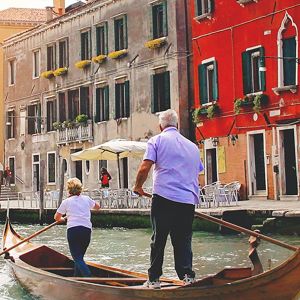
Attractions

Culture & History

Family & Kids

Food & Wine

Local Holidays

Nature & Wildlife

Relax & Recharge

Romantic & Honeymoon

Sports & Events

Sustainable & Eco

Winter & Ski

Top destinations

Popular holiday destinations
Australia holiday deals
United States of America holiday deals
Fiji holiday deals
Indonesia holiday deals
UK and Northern Ireland holiday deals
Singapore holiday deals
Thailand holiday deals
Italy holiday deals
New Zealand holiday deals
France holiday deals
United Arab Emirates holiday deals
Canada holiday deals
Greece holiday deals
Spain holiday deals
Maldives holiday deals
Vietnam holiday deals
Mexico holiday deals
Netherlands holiday deals
Germany holiday deals
Malaysia holiday deals
Japan holiday deals
Switzerland holiday deals
Cook Islands holiday deals
Ireland holiday deals
Vanuatu holiday deals
French Polynesia holiday deals
New Caledonia holiday deals
South Africa holiday deals
Mauritius holiday deals
Iceland holiday deals
More about Europe Deals
Create your own trip, site quick links, help & support.

Flight Centre acknowledges the Traditional Custodians of Country throughout Australia.
© Flight Centre Travel Group Limited. ATAS Accreditation No. A10412.
*Travel restrictions & conditions apply. Review any specific conditions stated and our general terms at Terms and Conditions . Prices & taxes are correct as at the date of publication & are subject to availability and change without notice. Prices quoted are on sale until the dates specified unless otherwise stated or sold out prior. Prices are per package.
What to budget for a 4 week holiday in Europe (by car or train)
If you’ve ever considered taking a holiday to Europe you’ve no doubt wondered how much does a trip to Europe cost? Knowing exactly how much to budget for a holiday to Europe can be one of the hardest parts of the trip planning process and this article is here to help.
As well as the initial expenses of flights and accommodation there are lots of other costs to take into consideration including transport, travel insurance, sightseeing, incidentals and spending money.
Your Europe trip budget can quickly get out of control if you don’t keep an eye on your expenses, so I’ve provided the actual costs from my recent European vacation (July 2017) to help you determine what to allocate in your Euro trip budget.
What's in this Article
How much does it cost to travel Europe for 4 weeks?
The real answer to this question depends on your own personal preferences. How do you plan on travelling around Europe? What standard of accommodation do you prefer? How many people are travelling with you?
The answers to these questions will help you to determine your budget for travelling Europe.
This is not a guide on travelling Europe on the cheap! It’s a guide to help you calculate how much you need to travel to Europe.
My backpacking days are long gone and when I travel now I prefer to stay in hotels or apartments that have at least a 4-star rating. My Europe holiday budget is usually around $250 per night but you might be happy with 3-star accommodation, in which case your accommodation budget will be less than what I have allowed below.
Some countries and cities are much more expensive than others so this can impact on your daily accommodation budget for your European holiday, too.

Similarly, your transport costs might be different to mine. The car hire costs below are based on a small car suitable for two adults and work out at $71 per day including the collision excess waiver insurance. Two of the rental cars we hired on this trip had automatic transmission but it is often cheaper to rent a car with manual transmission.
If there are more than two people in your travelling group, you’ll probably need a larger car so you’ll need to increase the budget mentioned below for your vehicle.
BUDGETING TIP: For car rentals in Europe longer than 21 consecutive days, you should consider leasing a vehicle as the daily cost can reduce significantly the longer you require the car.
Further reading: A step by step guide to the tax-free vehicle leasing program in Europe
1 month in Europe budget (travelling by car)

The prices below are based on the 26 day holiday to Germany, France and Switzerland my husband and I took in July 2017. (Prices in Australian dollars.)
(Expenses are itemized below)
^This is the maximum amount I would expect to pay for 2 x Economy class airfares from Melbourne to Europe and return during high season. By booking well in advance and taking advantage of the annual Early bird fares, you may be able to pay significantly less.
Further reading: Booking flights to Europe: A How-To Guide

Budget for 4 week holiday in Europe (by train)
Had we travelled by train instead of renting cars in each country we visited, the cost of our trip would have changed as follows.
Total trip cost above: $18,735 less car hire of $1,625 and International Driving Permit of $39 = $17,071. Add Rail Pass for two people, cost $2,870 = Total holiday cost for above trip travelling by rail = $19,941.
The Rail Pass price is based on a 15 day Global Flexi Pass of $1435 per adult which allows you to travel on the Eurail network in 1st class for any 15 days in a 2 month period.
Seat reservations (at additional cost) are required on some high speed rail services. Cheaper passes are available if less travel days are required or if both adults are travelling together on all sectors .
Further reading: How to use your Eurail Pass

Summary of expenses (as above) for my 2017 European trip
- Car hire in Germany (Pick up and drop off at Frankfurt airport) – 4 days hire of Peugeot 308 automatic – EUR259 = $398
- Car hire in France (Pick up at Toulouse airport and drop off at Narbonne station) – 11 days hire of Renault Clio manual – EUR330 = $487
- Car hire in Switzerland (Pick up at Geneva city depot and drop off at Zurich city depot) – 8 days hire of VW Golf automatic -CHF555 = $740
Total car hire costs = $1625 (averages out to $70.65 per day)
- 4 nights accommodation in Boppard (Germany) – EUR806 room only = $1240
- 2 nights accommodation in Toulouse (France) – EUR250 room only = $385
- 2 nights accommodation in Bruniquel (France) – EUR320 room only = $492
- 7 nights accommodation in Olonzac (France) – FOC*
- 1 night accommodation in Yvoire (France) – EUR220 room only = $338
- 7 nights accommodation in Lauterbrunnen (Switzerland) – $2573
- 2 nights accommodation in Zurich (Switzerland) – CHR591 = $788 (incl. breakfast)
Total accommodation costs = $5816 (averages out to 25 nights @ $232.64 per night)
*My husband and I are part owners of this holiday house. The normal weekly rent for guests during July is $940.

Other expenses:
- Flight Frankfurt to Toulouse – EUR530 = $815
- Train Narbonne to Geneva – EUR114 = $175
- Travel insurance – $265.75 (28 day duo policy)
- International Driving Permit – $39
Keep in mind: I booked the above trip just three weeks prior to departure (July 2017). Had I been able to book further in advance I may have been able to take advantage of early bird discounts or secured better prices and reduced my Europe travel budget significantly.
AUD rates based on an exchange rate of 1AUD = EUR.065 and CHF0.75 which was the approximate exchange rate during July 2017.
How much to allow per day in Europe?
Rather than a daily budget I usually allocate a set amount of spending money per week. Then I just multiply that amount by the number of weeks I’ll be away to calculate what I’ll need in the way of spending money in Europe.
I usually allow between $1000 and $1500 per week to cover meals, groceries, fuel, road tolls/vignettes, sightseeing, souvenirs, etc. On my recent trip, the amount budgeted of $1250 per week was more than enough to cover all our daily expenses including a few fancy dinners.
The amount of spending money you require will vary depending on whether or not you pre-purchase sightseeing tickets, the currency exchange rate at the time you travel, etc.
Further reading: Which travel money card is best?
Other expenses that you might need to include in your Europe holiday cost
- Arrival/departure transfers
- Sightseeing tours and entrance tickets
- Public transport/metro tickets
- Tolls and Vignettes on some motorways
Download my free European holiday planning tools here >>

My top holiday budgeting tips
- Pre-pay as many of your holiday expenses as you can before you leave home. That way, you’re not dipping into your spending money for large costs like accommodation or train tickets whilst you are on holiday.
- By booking well in advance you can often take advantage of early bird deals.
- If staying in hotels, try and secure a rate that has breakfast included.
- For stays of more than three nights in one destination, consider booking an apartment. Rates are often cheaper than hotels and apartments also give you the option of preparing your own meals which can be a big cost saver.
- Look for accommodation that includes free WiFi.
- Pre-load your spending money onto a travel money card. The exchange rate is locked in on the day of purchase and you can add additional funds at any time.
- Take more spending money than you think you will need. It’s better to bring some home than have to miss out on a gondola ride in Venice or a cable car trip in Switzerland because your funds are running out. These might be once in a lifetime experiences – don’t let a shortage of spending money leave you with regrets.
All prices are in Australian dollars.
PIN FOR LATER

Image: © alain wacquier / Dollar Photo Club Save
Carolyn's love affair with Europe started on her first visit over 30 years ago and it continues, just as strong, today. She visits Europe annually and enjoys writing about her discoveries and sharing her tips with fellow travellers.
You Might Also Like...

Iceland Summer Packing List

Packing list for a summer holiday in Europe

How to save money for European travel

European Itineraries: 1 month (30 day) self-drive tour of France

7 awesome day trips by train from Italy's major cities
Home Compare Credit Cards Travel Credit Cards How much to save for a trip to Europe
How much to save for a trip to Europe
Whether Brussels or Barcelona is your final destination, budgeting for a trip to Europe can be a challenge.
By Rachel Horan
on 03 Mar 2022
Fact Checked

Being unable to travel for the past two years has been a bummer for a lot of people (myself included). Now that international travel is finally back on the cards, you can bet that I will be packing my bags and jetting off to Europe at some stage this year. Of course, I’ll need to save for it first.
New research from CommBank revealed that 70% of Aussies are planning an international or domestic holiday in 2022, aiming to save an average of $5,000 for their trip. But is this enough money? Particularly if you’re planning a full-blown European getaway - the flights alone will take up a significant chunk of that five grand.
See how much you should have saved for a Europe trip
From flights to fancy dinners, there are a lot of expenses that need to be accounted for; some of which might slip your mind. For example, you still need to keep on top of your rent or home loan .
Realistically, how much do you need to have saved to enjoy your European escape? Whether you plan to sip wine in the Italian countryside or enjoy the coffee shops in Amsterdam; let’s discuss how much you should save.
Accommodation
Other travel costs, tourist attractions.
Food/drinks
Travel insurance
Home expenses
Recreational spending
Case study: Katie goes to Europe
This is likely going to be one of your biggest expenses when embarking on your European holiday. I’m only talking about your flights from Australia to Europe; not any in-between flights (we’ll get to that later). No matter where you’re flying off to, flights to Europe are going to cost you quite a bit of money.
If we were to look at a map of Europe, it’s clear that Greece is one of the closest countries to Australia while Ireland is one of the furthest away. These are both also highly popular tourist destinations, so let’s have a look at flight prices to and from these hot spots.
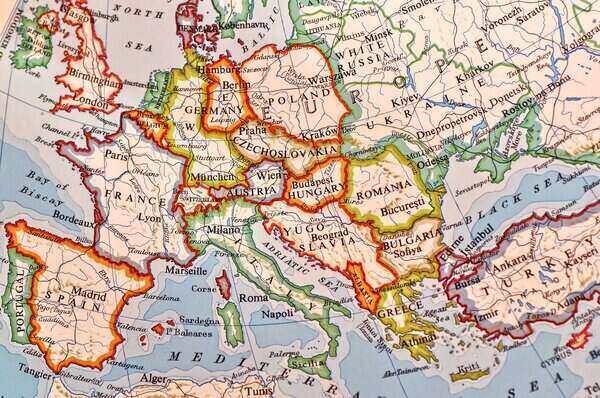
Athens, Greece
Flying from Sydney to Athens will typically require a stop over somewhere as it’s still a 15,317 kilometre journey. With this in mind, it’s probably going to be a similar flight time as you’d find travelling to any other European destination, despite being technically less ground to cover.
To find the best deals on Skyscanner, I’ve had a look at prices over the whole month of July 2022. This shows the cheapest and most expensive days to fly throughout the entire month you’ve selected.
From my market research, I found that flying out on 10 July 2022 and returning on 30 July 2022 could see a total round-trip costing as little as $1,341 according to Skyscanner. However, when you actually click thorough to ‘find flights’, you’ll find a different story. The cheapest flights available are through Singapore Airlines for $1,641. On the way there, you’ll have a full 27-hour stopover in Singapore and a 15-hour stopover on your way home. This makes it a 47-hour trip there, and a 34-hour trip back to Sydney.
The ‘best’ economy flights were through Qatar Airways for $1,789, with a quicker 24-hour journey to Athens and a 20-hour trip home.
Prices accurate at the time of writing and are likely to change. See Skyscanner for current flights and prices available
Dublin, Ireland
Almost another 2,000 kilometres away from Athens, Dublin is one of the furthest cities in Europe you can get to from Australia. Again, Skyscanner claims you can get there and back for as little as $1,400 if you leave on 7 July 2022 and return on 19 July 2022. But this time, the flights in question actually exist.
Taking off in the morning with Japan Airlines, getting to Dublin will require two stopovers: in Tokyo and London. Even still, the total flight time is just shy of 35-hours. Same two stops on your way back, but with shorter connection times would see you home in just under 30-hours. Flying economy, you could snag these seats for $1,400. These flights were also considered to be the ‘best’ option by Skyscanner.
Now onto where you’ll stay. Depending on your budget, there are a few options available: hotels, hostels, or even Airbnbs.
To see how much or little you may need to spend on accommodation, let’s look at the prices in the ‘most expensive’ and ‘least expensive’ cities in Europe. According to a recent survey by Cheaprooms.co.uk, Zurich, Switzerland is the most expensive destination in Europe when searching for double rooms rated at least three stars. On the other hand, Warsaw, Poland is home to the cheapest five-star hotels in Europe according to flight and hotel comparison site Kayak.
Since these destinations may not be the most popular in Europe, we’ll also list the hotel, hostel, and Airbnb costs in popular cities like London, England; Paris, France; Berlin, Germany; Rome, Italy; and Amsterdam, The Netherlands.
Using Booking.com, I searched for hotels in Zurich, Switzerland from Monday 11 July 2022 to Friday 15 July 2022. The cheapest available hotel accommodation was $521, while the most expensive hotel was a whopping $7,955 for four nights.
For the same dates in Warsaw, Poland, the cheapest hotel was $157 for a four-night stay, and the most expensive hotel was $1,523.
Here are lowest and highest-priced hotels for the same dates in the five cities mentioned above:
London: $341 to $7,780
Paris: $250 to $9,007
Berlin: $316 to $2,617
Rome: $247 to $13,871
Amsterdam: $431 to $5,947
Prices accurate at the time of writing
The cheapest hostel for the same dates in Zurich was $436 for four nights in a six-bed dormitory. Notably, there were also only nine hostels available to stay in, which wouldn’t be the case in most expensive European cities.
The cheapest hostel for the same dates in Warsaw, Poland was $101. In Warsaw, there are currently 49 hostels to choose from, all of which are under $200 for this four-day stay.
For the same dates, here are lowest and highest-priced hostels in the five cities:
London: $177 to $1,417
Paris: $264 to $1,227
Berlin: $171 to $1,073
Rome: $195 to $5,699
Amsterdam: $303 to $1,984
For an Airbnb in Zurich from the 11 to 15 July 2022, your prices will range from around $625 to $2,000. Most prices were closer to the $1,000 mark, and there were over 300 stays available for this date range.
For the same dates in Warsaw, prices range from around $200 to $500.
These are the average total prices to stay in the five cities for the dates mentioned according to Airbnb.
London: $1,663
Paris: $1,460
Berlin: $1,088
Rome: $1,014
Amsterdam: $1,571
With the countries in Europe being so close together, chances are you’ll do some more international travel while you’re there. You’re a long way from home, and it’s expensive to get over to Europe, so it’s definitely worth travelling to at least a few countries while you can.
Travelling within Europe is similarly-priced to travelling within Australia. This is likely because, geographically, Europe and Australia are pretty similar in size.
To give you an idea of how much this may cost you, let’s say you’re travelling within the five popular cities I’ve been mentioning. The price range for flights between the five cities are the following in July 2022 according to Skyscanner:
London to Amsterdam: $45 to $98
Amsterdam to Berlin: $59 to $142
Berlin to Paris: $51 to $90
Paris to Rome: $32 to $119
Rome to London: $32 to $112
Though I didn’t scroll through all the flights available, I’d be willing to put money on the cheapest flights being through the notoriously-cheap airline, Ryanair.
If you’ve done enough flying on your way to and from Europe, there are also bus and train options to consider. Though, for the Rome to London leg, I’m not sure a bus would be possible (or time-conscious; you’re not there forever).
Here are a few train costs between these cities:
Amsterdam to London: From $89.75
Amsterdam to Paris: From $55
Amsterdam to Berlin: From $94
Paris to Berlin: From $72.41
Berlin to Rome: From $75.27 (but it takes roughly 21 hours!)
Prices converted from Euros to Australian Dollars and accurate at the time of writing
If you travel half-way around the globe, you best believe you should see all that the cities have to offer. While you can definitely have a good time without paying to get into any attractions, many of the iconic ones will come with a price tag.
With this in mind, here are the costs of entering some of the most popular tourist attractions across Europe.
Eiffel Tower: €25.90 to get to the top ($40.80)
Colosseum: €16 ($18.90)
Louvre Museum: €17 ($26.78)
Acropolis of Athens: €20 ($31.51)
Palace of Versailles: €18 ($28.35)
Anne Frank House: €14 ($22.05)
St. Mark’s Basilica: Free
Trevi Fountain: Free
Van Gogh Museum: €19 ($29.92)
Food and drinks
While the ‘bigger’ price tag will be on the travel and accommodation costs, you still have to eat (and drink; you’re on holiday!).
Depending on how much you eat and the kinds of places you want to dine in at, your food costs may vary. But I strongly believe it’s better to err on the side of caution.
According to Contiki, cheaper fast food across Europe is around €9 to €15 and restaurant prices start at €15. With this in mind, Contiki recommends having a food budget of at least €40 to €70 per day (or $63 to $110 at the time of writing) if you plan on eating out for every meal. Lunch and dinner will likely be your bigger meals of the day, while breakfast may involve a visit to your local bakery or hitting the shops for some bread.
In terms of alcohol, depending on where you go, you’ll find it’s pretty cheap. In Prague, for example, a bottle of wine is equal to around $10, while a pint of beer is $2 according to Prague Czech Travel. According to Eurostat, prices of alcohol are highest in Finland, followed by Ireland and Sweden, while they were lowest in Romania, Bulgaria, and Hungary.
With this in mind, budgeting for alcohol will depend on where you are, what you’re drinking, and how much you’re drinking. In my own personal experience, I found alcohol to be substantially cheaper in Europe than in Australia. In The Netherlands, for instance, you can buy a bottle of wine from the shops for around $7 (it’ll be bad, but it’ll do the job). At the local club in Nijmegen, El Sombrero, you could get tequila shots for around $4, and a beer for about the same. While this was back in 2018-19, I doubt prices have risen substantially since then.
Another important cost when travelling that you may not think is necessary (but definitely is) is travel insurance. Travel insurance can cover you in events like your baggage being lost, your belongings being stolen, or getting unexpectedly sick and needing medical care. You might think ‘oh, those things would never happen to me’ but trust me: they can, and they might. Here’s a little anecdote for you, and an insight into why everyone (including myself) thinks I have bad luck.
In my time in Europe, these are the instances when I had to claim on my travel insurance:
My baggage was lost for nearly two weeks when I arrived in Amsterdam (I had to buy clothes, shampoo, conditioner, etc)
My passport was stolen in Paris (I had to travel home on a later flight, get an emergency passport, etc)
My phone and wallet was stolen in Nijmegen
I had countless doctors visits while living in Nijmegen as I was injured or mysteriously sick, which would have otherwise cost thousands of dollars
With these events in mind, I definitely saved a substantial amount of money by taking out travel insurance. It also just gives you some peace of mind just in case anything goes wrong. There are a few factors that can influence how much your travel insurance will cost and what you’re covered for, including:
Whether the country has a reciprocal health care agreement (RHCA) with Australia
Whether you’ll be on a cruise at any point
Whether you’ll be doing any snow activities (skiing, snowboarding, etc)
Whether you’ll be renting a car
How much luggage you’re taking over
To give you an idea of how much travel insurance may cost, I generated a quote through travel insurance company 1Cover for a 25-year-old solo traveler going to Europe from 7 July 2022 to 21 July 2022. For fully comprehensive cover, the quote was just shy of $130. However, if you were to take out travel insurance, I’d suggest getting multiple quotes before settling for the right fit for you, making sure you read the Product Disclosure Statement (PDS) and are paying attention to the excess amount.
This quote is an estimate based off little information and is accurate at the time of writing. For a more accurate estimation of costs, please generate your own estimate through an insurer.
Home expenses: Keeping up with the mortgage
Though less fun than watching Keeping Up With The Kardashians, keeping up with your mortgage or rent payments is just another expense that needs to be factored into your budget. Saving $4,000 for your holiday is all well and good, but if you need to fork out $1,000 in that time for your mortgage, you really only have $3,000 available to spend.
For myself, it’s easy to forget that, as an adult, I have to keep up with my financial commitments while I’m on holiday. For example, when I jet off I’ll still need to stay on top of my:
Water/gas/electricity/internet bills (if they come while I’m away)
Insurance expenses ( home and contents insurance , health insurance, etc)
Subscription services (e.g. Netflix, Spotify, and so on)
Other loan/credit card debts
Gym membership
And so on. You should tally up all your weekly/monthly expenses and account for these in your budget to make sure you’re not putting any financial strain on your getaway. It’s also a good idea to put a little extra money into your emergency fund , just in case something goes wrong and you need some quick cash.
Recreational spending money
On top of everything else mentioned, you still want some extra pocket money to spend on things like souvenirs, clothes, shoes and so on. You don’t want to be walking down the Avenues des Champs-Elysees - the iconic ‘shopping street’ in Paris - without any money to buy that pair of jeans in the window.
When it comes to how much to take with you, foreign exchange platform S Money said it’s ‘virtually impossible’ to know how much you might need. Of course, it will depend on your fashion taste - i.e. do you plan on shopping in Gucci or H&M - but S Money said a rough estimate would be around €100 per day ($157.12) in Western Europe and €40 to €60 daily ($62.86 to $94.28) for Eastern Europe. This includes spending money for food and drink - which we already discussed - so an additional €30 ($47.11) per day should be enough.
Now that we’ve gotten some pricing estimates and know what to account for, let’s look over a quick case study. Katie is a 25-year-old marketing manager who had a Europe trip planned before COVID came and kicked her plans out the window. Now that international travel is back on the table, she can’t wait to pick up where she left off planning her first trip to Europe.

Since it’s her first time visiting Europe, she wants to go to the main tourist spots: London, Paris, Berlin, Amsterdam, and Rome. She also has family in Salzburg, Austria, who she’ll pay a visit. Since she’ll be close to Hungary, she also wants to check out Budapest. She’s never seen snow, so she wants to travel in the winter (which is summer in Australia). She’ll be travelling with her boyfriend, Max, but they’ll be paying for everything separately - and anything they share they’ll split down the middle. They decided that in order to have enough time to save and plan their trip to their liking, they’re going to jet off in December 2022.
Cost breakdown
They decide that they want to land in London and depart from Rome as it makes the most sense geographically.
Using Skyscanner, they found that 2 December 2022 was the cheapest date to fly out. Flying out with All Nippon Airways, they choose a flight for $775 each. Based on reviews and location, they choose to stay at the Alexandra Hotel for four nights, which costs $ 350 each or $700 total.
They jet off to Amsterdam on 6 December for $81 each. They find a beautiful houseboat studio with sweeping views of the canal and city - and it comes with free bikes - where they’ll stay for three nights for $267 each or $534 total. They plan to see the Van Gogh Museum and Anne Frank House, which will cost them $29.92 and $22.05 respectively.
From Amsterdam they take an evening flight to Paris on 9 December for $106 each. They find a beautiful hotel for three nights costing them $196.50 each ($393 total). They simply have to see the Mona Lisa, so they plan to visit the Louvre Museum for $26.78 each.
They take off for Berlin on 12 December for $89 each. They find a stunning hotel for $211 each ($422) for their three-night stay.
On 15 December, they fly from Berlin to Salzburg for $79 each. They stay with Katie’s aunt and uncle for three days, who drive them around Salzburg and even take them to Vienna, Austria.
Unfortunately, there were no flights from Salzburg to Budapest so instead they decide to take the train for $67 each. They find a well-located and highly-rated suite for $68 each ($136 total) for two nights. They plan to visit the Szechenyi Bath while they’re there for $40 each.
Last stop before they go back to Australia is Rome, where they snag a $31 flight with Ryanair leaving from Budapest in the morning. From 20 to 23 December, they stay in a stunning hotel with views of Vatican City for $130 each or $260 total.
From Rome, they fly back into Sydney for $1,440 each (the price of flying so close to Christmas). They arrive home on Christmas Eve, just in time to be back with their families for Christmas.
They both also take out travel insurance for $160 each, and save a generous $3,150 ($150 per day) for spending money on food, drinks, and other recreational activities. They also both pay $225 ($450 total) for their rent per week ( $775 ) and $20 each for their gym memberships.
Once all this has all been added up, Katie is set to spend approximately $8,114.25 on her European getaway. To be safe, she decides to add an extra 10% and saves roughly $9,000 to be spent throughout her holiday.
So how much should you save to travel to Europe?
Ultimately, how much you end up needing to save and spend will completely come down to you; where you go, how you get there, and where you stay. If you want to travel on a budget, hostels and Ryanair’s last-minute deals might be the way to go. But if you want to stay in nice hotels, see the attractions that cost money and do a bit of shopping, you may need to save a little more.
When deciding how much to save and spend, these estimates may not be much use to you. Europe is a huge continent - with over 44 countries - and prices across them can vary greatly.
Tips for planning your Europe trip
As a seasoned traveller myself, I picked up a few tips and tricks to secure the best deals while still having a really great holiday.
Compare flights across multiple dates: Some days are cheaper to fly than others for some reason. Do your research to find the best times to fly and work out your holiday around these dates
Use multiple comparison sites to look for hotels: Again, some comparison sites will charge you a higher fee than others for the exact same hotel. Make sure you look around to find the best deal
Same goes for travel insurance: You should also use multiple sites to compare your travel insurance quotes. Also be sure to read the PDS and know exactly what you’re covered for, and that you’re going through a reputable, reliable insurance company
Don’t forget the free spots: Most European cities have a lot to offer that you don’t even need to pay for. Iconic tourist spots like the Eiffel Tower and London Bridge won’t cost you a cent to look at, and they’re great to see
Saving too much is better than not saving enough: You may think $150 per day for food and drinks is excessive, and chances are, you’re right. You likely won’t spend this much every single day on food, drinks and recreational activities. But trust me - it’s better to have money to spare than to run out
Account for exchanging Australian Dollars to Euros: I didn’t mention this, but thought I’d add it in at the end; plan on losing a little bit of money when exchanging your Australian Dollars to Euros. Whether you take out cash or use a travel credit card , there will be a tiny fee incurred whenever you exchange money which you should take into consideration
Main Image by Nastya Dulhiier on Unsplash; First embedded image by MabelAmber on Pixabay; Second embedded image by Gijs Coolen on Unsplash

Rachel Horan
Rachel is a Finance Journalist, and joined Savings in 2021. Coming from a background in the FinTech space, her interests include the innovation of lending technology, property, investing, and more. With a passion for educating and informing people about their finances, she hopes to increase the financial literacy of everyday Australians.
Related News

ANZ agrees to $57.5m settlement in credit card class action
Australians who held an ANZ credit card with an ‘interest free’ period prior to 2019 might receive compensation after the big four bank agreed to a $57.5 million class action settlement.

1.8 million card fraud victims in Australia last year
The 22/23 financial year saw a slight decline in Aussies victimised by scams, but 1.8 million people were exposed to credit card fraud with $2.2 billion stolen according to personal fraud statistics from the ABS.

Cash withdrawals increase in January
RBA data shows cash withdrawals increased 1.6% from January to December 2023, with a petition to guarantee access to cash in Australia at more than 160,000 signatures.
Related Guides

Happy with your credit card rewards? 70% of Aussies aren't during COVID
With international travel limited thanks to COVID, Aussies want more from their credit card rewards.

What are the biggest banks in Australia?
When choosing a financial institution for your banking needs, it’s useful to know who the major players are in the Australian banking landscape.

Consumer anxiety spikes in face of coronavirus pandemic

Aussies spending more on DIY during isolation

What is the gold standard?

Get news & tips delivered
By subscribing you agree to our privacy policy
© 2024 Savings.com.au · AFSL and Australian Credit License Number 515843
The entire market was not considered in selecting the above products. Rather, a cut-down portion of the market has been considered. Some providers' products may not be available in all states. To be considered, the product and rate must be clearly published on the product provider's web site. Savings.com.au, yourmortgage.com.au, yourinvestmentpropertymag.com.au, and Performance Drive are part of the Infochoice group. In the interests of full disclosure, the Infochoice Group are associated with the Firstmac Group. Read about how Infochoice Group manages potential conflicts of interest , along how we get paid .
Savings.com.au Pty Ltd ACN 161 358 363 operates as an Australian Financial Services Licensee and an Australian Credit Licensee Number 515843. Savings.com.au is a general information provider and in giving you general product information, Savings.com.au is not making any suggestion or recommendation about any particular product and all market products may not be considered. If you decide to apply for a credit product listed on Savings.com.au, you will deal directly with a credit provider, and not with Savings.com.au. Rates and product information should be confirmed with the relevant credit provider. For more information, read Savings.com.au's Financial Services and Credit Guide (FSCG). The information provided constitutes information which is general in nature and has not taken into account any of your personal objectives, financial situation, or needs. Savings.com.au may receive a fee for products displayed.
Explore the Infochoice Group network: InfoChoice · Your Mortgage · Your Investment Property · Performance Drive
Our company, Savings.com.au, has obtained accreditation as a data recipient for the Consumer Data Right (CDR). You can view our CDR policy by clicking on this link .
Be Savings Smart.
Subscribe to our newsletter.
TTC family of brands
My Costsaver
Destinations
1300 302 118

EUROPE AND BRITAIN 2025, OUT NOW >
See more Europe trips
DON'T TAKE OUR WORD FOR IT
Essential europe bucket list items by us.
A European tour with Costsaver will have you falling in love with all the iconic sights, from the ancient streets of Rome to the rolling mountains of Scotland.

Wander the Romantic Streets of Paris
Audrey Hepburn once said “Paris is always a good idea”, and we couldn’t agree more. The City of Love is famed for its romance and historic sights, from the Louvre to the Eiffel Tower. Whether you strut down the Champs-Élysées, stroll along the Seine River, or slip down a cobbled alleyway, you’ll find magic in Paris at every turn.
Experience on: European Delight

Explore the Scottish Highlands
Get ready to explore one of the most beautiful places on Earth. You’ll journey under wide open skies through ancient castles, sweeping glens and wild waterfalls. Hear tales of a haunted past in Glencoe Valley, see the ruins of Urquhart Castle, and keep an eye on the lakes for Nessie. Europe sightseeing doesn’t get much better than this.
Experience on: Britain & Ireland Explorer

Lose Yourself in the Awe-inspiring Beauty of Rome
Rome is one of the best destinations in Europe and for good reason. The whole city is on our Europe bucket list, and you’ll have some of the world’s best food, architecture and history in the palm of your hands. Toss a coin in the Trevi Fountain, explore the treasures of the Vatican, stand where gladiators once battled at the Colosseum… and that’s just the start. Experience on: Italian Scene
EUROPE TAILORED BY YOU
Create your own rules on a tailor made holiday to Europe with our range of Choice Experiences. Choose from adventures like experiencing a flamenco show in Spain and discovering the ancient wonders of Mykonos in Greece.

Costsaver team member
Visit a Rooftop Bar in Florence
For the ultimate cocktail experience, head to La Terrazza Continentale. You'll pay big bucks for the cocktails but with it comes the most spectacular view of the city of love. Sit back, marvel and sip at your aperol while you people watch.

Discover Castles in Bavaria
Bavaria has plenty of magical, story-book castles and it’s not hard to find them either as they loom over the clearings in dark forests or stand majestically upon craggy outcrops, punctuating the landscape as you pass. There are hundreds of historic castles in this part of Germany, but my absolute favourite ones I recommend you discover on your Costsaver tour are Neuschwanstein and Hohenschwangau. Stunning!

happy Get Going past guest
Experience a Flamenco Show in Spain
You can't miss out on witnessing the fiery flamenco dance when you visit Spain. We got tickets to the best show in Seville and discovered the rhythm and passion of the traditional Andalusian flamenco. We were so captivated by the moving guitar, the beautiful singing, and the clapping and thumping steps of the dancers... It was an experience we'll never forget.
WHAT TO EAT & DRINK IN EUROPE
From pizza to paella, gyros to goulash, croissants to carbonara, and all sorts of delicious soups, stews and pastries in between… European food is simply iconic.
Full English Breakfast (England)
What better way to start your day than with a full English breakfast? It’s hard to beat this classic British dish, piled high with buttered toast, fried bacon, grilled tomatoes, mushrooms, beans, eggs and black pudding. Finish off a full English and you’ll have the energy to go all day.
Coq Au Vin (France)
France is famed for its fine food and Coq au Vin is one of the country’s greatest creations. The dish features chicken braised with wine and served with mushrooms, bacon and garlic. It’s cooked stew-style and is one of the most comforting dishes you’ll find in France.
Carbonara (Italy)
Wondering what to eat in Europe? You can’t miss out on an authentic carbonara in Italy. This beloved pasta dish originated as a coal-miner’s meal in Rome and today is made with egg, black pepper and lashings of Pecorino Romana or Parmigiano-Reggiano cheese.
WHEN IS BEST TO VISIT EUROPE
Whether you want to hit the beaches in summer, see vineyards bloom in autumn, or catch the snow in winter, Europe is the place to be 365 days a year.
Best Time to Visit Europe for Beaches
Whether you want to go island hopping on a European cruise, or simply laze on the golden sands of your choice, the glorious summer months are the best time to do it.
Best Time to Visit Europe for Winter
Winter is a wonderland in Europe and the best time to soak up the magical Christmas markets, snow and mulled wine is from December to February.
Best Time to Explore Europe’s Iconic Sights
The best time to tick off all the highlights like the Colosseum and the Acropolis is the shoulder months from April to June and September to October. You’ll still get great weather but with fewer crowds.
PACKING TIPS FOR EUROPE

HOW TO TRAVEL RESPONSIBLY IN EUROPE
Support the local communities
If you’re on the hunt for some great souvenirs or a fantastic meal, point your nose in the direction of locally-owned shops and restaurants. You’ll support local businesses and get an authentic experience.
Be kind to the environment
Europe is beautiful and you can help keep it that way. Cut down on litter by using a reusable water bottle, never leave any rubbish behind, and always stay on the marked paths when hiking in Europe.
Watch wildlife with care
You can take care of our animal friends by never touching or feeding any wild animals. It’s also best to avoid any exploitative wildlife experiences, such as harmful dolphin and whale watching tours.
YOUR EUROPE, YOUR WAY

Bosnia Herzegovina
Czech Republic
Netherlands
Scandinavia
Switzerland
LOOKING FOR MORE? SEE THE REST OF THE WORLD, YOUR WAY
North America
South America
Australia New Zealand
Help & info
Your Questions Answered
Travel Updates
Group Tours
Custom Tours
Sustainable Tourism
Travel with confidence
Travel planning
View and Request a Brochure
ZIP Financing
Booking Conditions
Tour Deposit Level
Costsaver is a proud member of The Travel Corporation family of companies.
Selected Region
United States
United Kingdom
New Zealand
South Africa
Copyright 2024 Costsaver. All rights reserved.
Website Terms of Use
Privacy Policy

Get our Rail Planner app
Plan your trip, get extra discounts, and show your Pass as you go.

Our favorite spring routes
Celebrate spring with these 7 off-the-beaten-path train routes

All about seat reservations
Everything you need to know about booking your seats

Alternatives to Busy Routes
Travel between popular European cities without seat reservations

Through our Chatbot in the bottom right corner.

Ask the Community
Browse questions from fellow Eurail travellers, or ask your own!
Passes guide
- Order overview
- Reservations overview
- My Trips & Travelers
- {{translatedTraveler}} {{#promotional}} {{currencySign}} {{standardPrice}} {{/promotional}} {{quantity}}x {{currencySign}} {{finalPrice}}
- Child {{childPasses}}x FREE
- {{translatedPassType}}
- {{translatedValidityPeriodDescription}}
- {{translatedClass}}
- Remove Pass(es)
- {{variant.localizedTravelPackDescription}} {{quantity}}x Free
- {{variant.localizedPassUpgradeDescription}} {{quantity}}x {{currency}} {{price}}
- Your order will arrive by {{expectedDeliveryDate}} 1 x {{currency}} {{price}}
Your cart is empty
Explore Europe by train with a Eurail Pass
Which Eurail Pass should you choose?
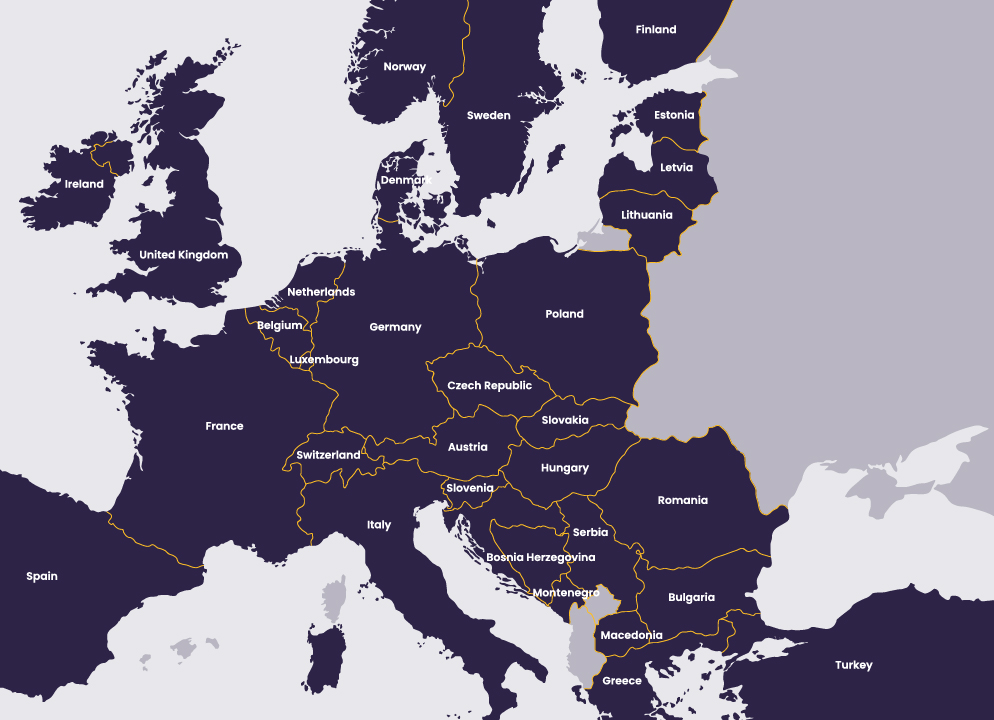
Travel in 2 or more countries
Eurail Global Pass
Travel by train to over 30,000 destinations in 33 European countries with our classic rail Pass. Choose this for multi-country trips or if you haven't decided on your destination.
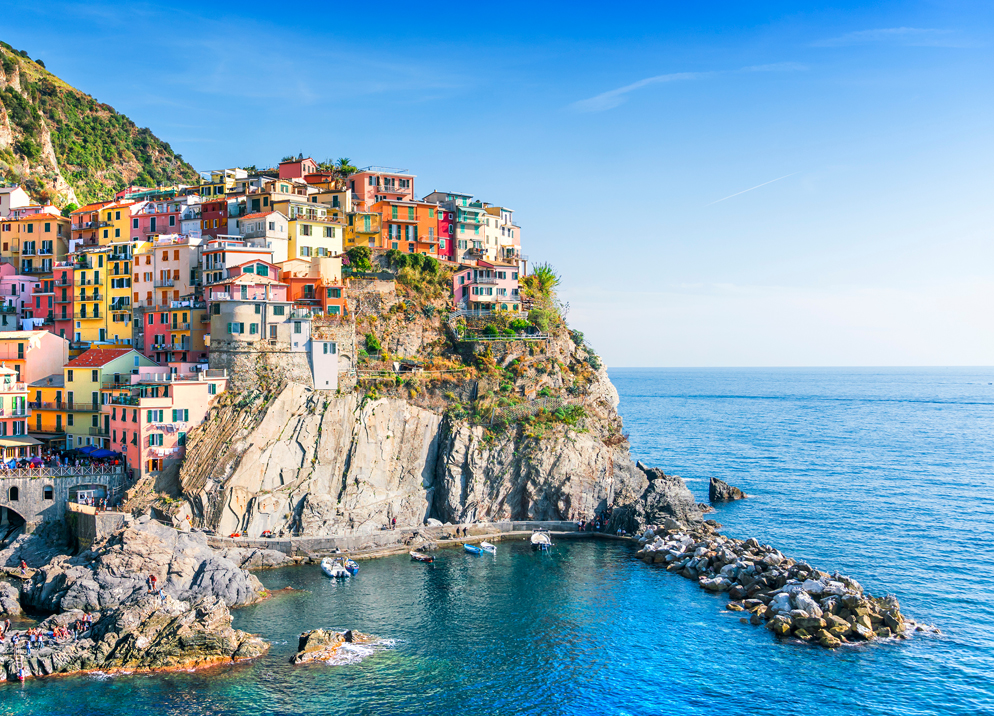
Travel in 1 country
Eurail One Country Pass
Only got one country on your mind? Explore as much of it as you like with a Eurail One Country Pass. You'll feel like a local in no time!
Meet our bestsellers
Global Pass
7 travel days
- Travel on any 7 days within 1 month
- Perfect for visiting 6-8 destinations
- 85% refundable if you change your mind
10 travel days
- Travel on any 10 days within 2 months
- Perfect for visiting 9–11 destinations
What's included in the Pass?
Hop on and off most trains in 33 European countries just by showing your Pass.
Free and instant delivery to your device if you choose mobile Pass.
Download the free Rail Planner app to plan your trip, store your Pass and show your ticket as you go.
Get extra benefits and discounts as you travel with our 100+ partners across Europe.
Eurail has flexible exchange and return policies that let you book with confidence.
Seat reservations. You'll need to pay an extra fee to reserve a seat or sleeper on high-speed trains, night trains and popular routes . Find out more about reservations here .
Other public transport. Eurail only covers trains. Trams, buses, rental bikes and metros are not covered by your Pass. Though you can get a discount in some cities .
Accommodation. You'll need to book and pay for this separately, though you can get a discount with our accommodation partners .
Change of currency
You cannot change the currency once you have a Pass in your cart. Remove the Pass, and then change the currency on the website header.

Find cheap flights from Europe to Australia from $645
This is the cheapest one-way flight price found by a kayak user in the last 72 hours by searching for a flight from europe to australia departing on 16/5. fares are subject to change and may not be available on all flights or dates of travel. click the price to replicate the search for this deal., search hundreds of travel sites at once for deals on flights to australia.
Save 19% or more Compare multiple travel sites with one search.
Track prices Not ready to book? Create a price alert for when prices drop.
Free to use There are no hidden charges or fees.
Filter your deals Choose cabin class, free Wi-Fi and more.
Good to know
Faqs for booking flights from europe to australia, how does kayak find such low prices on flights from europe to australia.
KAYAK is a travel search engine. That means we look across the web to find the best prices we can find for our users. With over 2 billion flight queries processed yearly, we are able to display a variety of prices and options on flights from Europe to Australia.
How does KAYAK's flight Price Forecast tool help me choose the right time to buy my flight ticket from Europe to Australia?
KAYAK’s flight Price Forecast tool uses historical data to determine whether the price for a flight to Australia from Europe is likely to change within 7 days, so travelers know whether to wait or book now.
What is the Hacker Fare option on flights from Europe to Australia?
Hacker Fares allow you to combine one-way tickets in order to save you money over a traditional return ticket. You could then fly to Australia with an airline and back to Europe with another airline.
What is KAYAK's "flexible dates" feature and why should I care when looking for a flight from Europe to Australia?
Sometimes travel dates aren't set in stone. If your preferred travel dates have some wiggle room, flexible dates will show you all the options when flying to Australia from Europe up to 3 days before/after your preferred dates. You can then pick the flights that suit you best.
Top 5 airlines serving from Europe to Australia
I commend the flight attendants on our SFO-SIN flight who went above and beyond to provide us with extra snacks and food. This type of service makes the flight experience personal and awesome.
I requested an aisle seat and got a middle seat The flight gate was changed and the flight was delayed
When boarding, after business class should be premium economy, but economy class already lined-up at the gate blocking premium economy to board. Singapore airline crew should done a better job to organize this chaos :( Thank you.
Wonderful service, planes and interior in great condition, very pleasant experience
People were so nice! Economy seats were small and cramped feeling for me. I’m slender and 6 feet tall
The singapore airline now compared before covid, I like the service before covid. SQ was the best of all airlines but now I am going to look for different airline if I am travelling in asia.
Perfect experience from boarding through to leaving the flight, comfortable and personalised service from all staff, highly recommended
They were able to assist my elderly father and myself after not being able to check in to scoot. The counter service was phenomenal. They did what they could to get us on the next plane so we could catch our Connecting flight. Scoot closed early on us so we ended up missing our flight.
Transfer within the same terminal and lots of facilities at the airport.
I did not like anything. Flight experience was bad overall.
Flight from Dubai to Zagreb very bad cabin crew. Bad food
Service needs to improve. Air hostess do not register flyers request and we need to keep on repeating our request to them on multiple occasions
I was traveling business purposes and I only had one carry on and a personal computer back pack . My carry on was 8.5 kg little more than allowable. At jfk airport check in they did not let me carry it . I was little disappointed.
I liked theAVML food. Taste was alright and quantity was enough. Sometimes during the flight I felt that the smell from toilet was coming to the cabin
Emirates is usually on time, but not this trip. Also, during the flight the attendants disappear unless called upon. Very strange. I have watched the quality of Emirates service diminish over the last five years.
The service was fantastic. Not much could be done better
Boarding was delayed but the information about delays was not provided
Food was not great. Crew members were created hassle with attitude at the gates and wasted my valuable time. I have been traveling in Emirates airlines many times. Over all not happy flying in Emirates airlines this time. Seats are very small and not comfortable. Seats looks like very very old and congested. It would be nice if they fix these kind of issues. I hope my next trip will be hassle free and comfortable journey in Emirates airlines. Thank you.
Premium economy on Emirate A380 is simply the best non-business class product. In fact its probably better than many business class if the seat isnt lying flat. The food and service is close to perfect!
1. Please deploy better trained and courteous staff. 2. Wheel chairs be available at all steps of layover till boarding gate. 3. Food services be also improved . 4. TV and phone charging facility be also provided.
Wuhan - Dubai. Old plane: 1. Only USB charger. No power outlet to plug in.. 2. Super narrow seat layout 3. Toilet cover consistently fell down and hit my back when sitting on it.. :( 4. Entertainment system touch screen not sensitive, and need to press hard or use finger tips to hit. Crew were very nice and accommodating though.
1. I got very poor check in experience with the counter lady . This is the first airline I ever experienced that no combine check in weight allow . Even we have 4 of us but weight counter by piece . So we wasted lot of time argue and repack . This is super crazy 2. Next I left my Samsung tablet on the plane . And I started to escalate and finally spoke to southern airline lost and found in Malaysia and the amazing answer she give is : system nothing found and please try to call southern airline in china 🧐 . I have been flying many other airlines but this is my first encounterment with such irresponsible airline response and no empathy given to customer . My feeling is nobody bother whether how customer like me feel and I’m just too small for the management to take note .
No red vine, no whiskey, no vodka. No that I wanted all of them at once but still...
During flight, some passengers perform stomping leg exercises which disturb the comfort (I.e. sleep) of other passengers.
The flight was okay it was the kayak customer service that was poor, I have been trying to change my name on my flight ticket 3 days before my flight and nothing got done about it even tho I messaged so many times and phoned, all I got in return was that is was being processed and still to this day nothing has been done about it, I think it’s disgusting and un needed stress to the trip.
Quality flight from start to finish. Customer service is evidently very important to this company. The staff really exceeded expectations.
Traveling with the Chinese airlines , their service superior to the US Airlines , they are much more friendly and the seats are comfortable , In the past I flew with United , now ,United Airline will become history for me .
The made us waiting and held our passports and boarding pass making us miss our flights
From Montreal to Doha , we habe two complaints : 1) They want to charge for Seat Selection, claiming that the Class of ticket bought on Kayak did not cover seat selection. It such a penny pinching rule, I told them, since we paid almost $20,000 our 3 tickets , that rule should never exist. Also I reserved my tickets so many months ahead, I expected they will naturally put the family together or move somebody else to keep our family seating together. I filed a complaint, and NOBODY ANSWERED. 2) In Montreal, Qatar has an arrangement with the National Bank Lounge. It was so overcrowded and the Lounge is so bad in terms of service and food, amenities etc... The WORST lounge . Why Qatar not have another arrangement their Business Class clients in Montreal. The Air France KLM Lounger is better, the Air Canada Lounge is better. Qatar should send somebody to take a look ! Joseph Chung
They shld improve and provide a lunch or dinner in an international leg
The crew was courteous and efficient. There was no entertainment or liquor service on this short international flight.
Boarding procedures are very tiring. We have to clear security twice for our connecting flights from Doha. Also every time we board flights we have to show boarding passes 5-6 times.
I had never seen any cabin crews behaving like that. They are not at all professionally fit for this job
Asian Veng meal have Non Veg items which is not ok. Pure veg meals option are too less and they have inclusion of Vedgan and Lactos etc... which is taste less
Boarding delayed, no communication. I left the lounge, and heard a final call, boarding started after a 30 minutes.
The business class experience was awesome - I will be using QATAR airways again and it'll be business class again - appreciate the privileges afforded to the business class clients - thank you.
Food and Service inside the flight. Airport service from Qatar is not good mainly because of lack of coordination and not used of seeing so many ppl commuting
Nothing really was great as such. Seen other no name airlines perform better.
Not a good experience from Lagos was very terrible paying for one extra bag is #403,600 in dollars is $331 which is too high and when get to Ny I don’t receive my bag till 2nd day some of my stuff was damaged am not really happy with Turkish Airlines very poor services.
COmpared to my experience in the business class of other airlines the food variety and offerings were meager. They did not have any cookies or crackers for snacking! They were unable to offer some other items. This has never been my experience in other airlines.
The airplane from IAD to Istanbul was too old. The chairs were to tight and uncomfortable. I continued my travel from Istanbul to Bangkok. This airplane was better and newer than the first one. Even food was better.
Flight attendants were harsh, food could be better, took way too long to pick up food trays, were stuck with the crying babies the entire to and from trip. Restrictions of 8 kg for cabin luggage is ridiculous that’s barely 2 pairs of pants, shirts, shoes. There shouldn’t be any restrictions on the carry on luggage size except the checked in luggage. Attendants don’t even help with putting luggage in cabin space. Attendant picked up food tray and spilled cherry juice all over my husband and has the nerve to come back to ask why he hadn’t changed his clothes.
the female flight attendant was racist towards me. I could tell she treated the two other passengers next to me with more softness.
My whole body was paining after such long flight. Seats are small. Leg space is too small. Food is good.
Sadly, the plane was extremely old and uncomfortable. The entertainment system broke down completely. We couldn't even charge our phones. The seats were also very uncomfortable, with a very slim seat cushion. It must be the result of having 9 seats where there used to be 8.
I canceled this flight after turkish airlines did not provide any consideration for a death in the family while in Singapore
No wifi at all during the entire flight from Istanbul to Miami.
Book cheap flights from Europe to Australia
Recent return flight deals, search by stops, search by airline, search by price, recent one-way flight deals, last minute flights from europe to australia, last minute flight, train and bus deals, flights to australia, return flight deals:.
Australia - Europe
Cabin classes:
Browse origins:.
- Flights »
- Worldwide »
Browse destinations:

IMAGES
VIDEO
COMMENTS
From AU$1,680^ per person. 7 nights in Paris, 7 nights in Barcelona, 7 nights in Rome and 7 nights in Athens (in budget accommodation) Public Transport. AU$450. For a youth, 2nd class ticket that allows travel on 5 days within 1 month, for 5 European countries of more. Total.
The total cost will depend on various factors such as the duration of your trip, the countries you plan to visit, your preferred level of comfort, and the activities you wish to partake in. However, to give you a rough estimate, a 2-week trip to Europe from Australia can cost anywhere between AUD 5,000 to AUD 10,000 per person, excluding flights.
Average Trip to Europe Cost in 2024. An average seven-day vacation in Europe costs close to $1,800. This can be broken down as follows: Average Accommodation Cost: $455. Average Flight Cost: $750. Food, Drinks & Activities: $378. Transportation: $200. Total Cost: $1,783.
Nov 6, 2023. One-Month Europe Trip on a Budget: A Full Itinerary and Cost breakdown. This guide includes my full itinerary and cost breakdown for accommodations and transportation between cities. It also contains things to do and where to stay in London, Paris, Ghent, Bruges, Barcelona, Seville, Granada, Cordoba, and Madrid.
Firebird Tours, LLC: 401 E. Las Olas Blvd, Suite 1400 Fort Lauderdale, FL, 33301, US
An average direct flight from Australia to Europe takes 24h 29m, covering a distance of 25654 km. The most popular route is Melbourne - London with an average flight time of 23h 15m. What is the cheapest flight to Europe? The cheapest ticket to Europe from Australia found in the last 72 hours was $1,252 one-way, and $1,049 round-trip.
Factors Affecting the Cost of a Europe Trip from Australia. Airfare: The cost of flights is typically one of the significant expenses when planning a Europe trip from Australia. Factors like the time of year, airline, and booking in advance can significantly impact the price. Accommodation: Depending on your preferences, accommodation costs can ...
Backpacking Europe Suggested Budgets. Prices for travel in Europe vary greatly depending on how far north, east, south, or west you travel. If you stick to the budget accommodations, food, and tours listed here and use all my tips on saving money, you need about 65-110 EUR per day in Western Europe, 40-50 EUR in Eastern Europe, and about 85-130 EUR in Scandinavia.
The cost of a trip to Europe from Australia largely depends on the countries in the euro area you're planning on visiting, the experiences you're willing to pay for, and your budget limits. To help you better budget for your trip is our compilation of the most common costs you'll come across during our travels around countries in Europe.
In this comprehensive guide, we will cover everything you need to know to make your European adventure a success. Flights. One of the first things to consider when planning a trip to Europe from Australia is the flight. There are several airlines that offer direct flights from Australia to Europe, including Qantas, Emirates, and Singapore Airlines.
Visas. Australian citizens do not need a visa to travel to most European countries for tourism purposes for up to 90 days. However, it's important to check the visa requirements for the countries you plan to visit, as some may have different rules and regulations. For example, if you plan to stay in Europe for more than 90 days or work while ...
Rome to Amalfi. Jordan · Traveled March 2024. This was the best trip we've ever taken! Matteo's enthusiasm and organization made for an stress-free, adventure-packed tour of Italy. His expertise and passion made for an unforgettable Italian culture immersion. Review submitted 29 Mar 2024.
In this video, I break down the cost of my 4-week Europe trip from Australia in 2023. I include the cost of flights, accommodation, activities, and transfers...
Some of the most beautiful beaches are Mykonos, Crete and Santorini. food budget per day: $25-$35. guided tours cost per day: $30-$50. accommodation cost per day: $25-$50. 3-week budget: $1,700-$2,800 (excluding flights to and back) CHECK-OUT: Best itineraries for 3 weeks in East Europe.
But, a good estimate is about $4,280. One time I spent just $2,300 because I focused on doing it for as cheap as possible. Another time I spent closer to $8,000 (for two people) when visiting just three cities. The cost of a Europe trip depends on you, but it's not hard to stretch your travel budget.
The cheapest way to get from Australia to Europe costs only $878, and the quickest way takes just 26½ hours. Find the travel option that best suits you. ... Find all the transport options for your trip from Australia to Europe right here. Rome2Rio displays up to date schedules, route maps, journey times and estimated fares from relevant ...
UK and Northern Ireland holiday deals. Singapore holiday deals. Thailand holiday deals. Italy holiday deals. New Zealand holiday deals. France holiday deals. United Arab Emirates holiday deals. Canada holiday deals. Greece holiday deals.
Budget for 4 week holiday in Europe (by train) Had we travelled by train instead of renting cars in each country we visited, the cost of our trip would have changed as follows. Total trip cost above: $18,735 less car hire of $1,625 and International Driving Permit of $39 = $17,071. Add Rail Pass for two people, cost $2,870 = Total holiday cost ...
For the same dates in Warsaw, Poland, the cheapest hotel was $157 for a four-night stay, and the most expensive hotel was $1,523. Here are lowest and highest-priced hotels for the same dates in the five cities mentioned above: London: $341 to $7,780. Paris: $250 to $9,007. Berlin: $316 to $2,617. Rome: $247 to $13,871.
European Adventures. 13 Days. 15 Cities. 8 Countries. 13 Day Europe Tour from London to Paris via Prague. From. $3,825. Standard Price $4,250.
Free and instant delivery to your device if you choose mobile Pass. Download the free Rail Planner app to plan your trip, store your Pass and show your ticket as you go. Get extra benefits and discounts as you travel with our 100+ partners across Europe. Eurail has flexible exchange and return policies that let you book with confidence.
Calls, including over Wi-Fi, are $.25/min. (no charge for Wi-Fi calls to US, Mexico, and Canada). Go5G plans: Up to 10GB high-speed data in select Central European countries; otherwise, standard speeds approximately 256 Kbps. Go5G Next and Go5G Plus: Up to 15GB high-speed data in 215+ countries and destinations, then unlimited at up to 256 Kbps.
Based on two of you including activities but minus the accomodation / travel costs between points, all in price of €100 a day in Norway / Sweden // €60 a day in Italy. 1400 + 840 = €2240 each for the month. Good luck!
Flights to Alice Springs, Australia. $2,046. Flights to Ballina, Australia. $2,433. Flights to Broome, Australia. View more. Find flights to Australia from $651. Fly from Europe on China Eastern, China Southern, Air China and more. Search for Australia flights on KAYAK now to find the best deal.
American Airlines - Airline tickets and low fares at aa.com